Professional Project: Housing Decisions of Older Australians
VerifiedAdded on 2020/05/28
|26
|5737
|50
Report
AI Summary
This report examines the influence of transfer systems and tax on the housing decisions of older Australians. It explores the background of housing policies in Australia and the significant role housing plays in the wellbeing and financial security of older individuals. The report investigates the objectives, research questions, and literature review related to housing choices, age pension, and government support. The research methodology uses an interpretative approach with secondary data analysis and quantitative methods to analyze how the transfer system and tax affect the older population’s decisions regarding homeownership, retirement, and living standards. Findings highlight the impact of age pension eligibility, asset tests, and income levels on housing choices, as well as the preferences of older Australians for staying in their homes. The report also provides recommendations for improving living standards and addresses limitations, offering a comprehensive analysis of the key factors influencing housing decisions in this demographic.
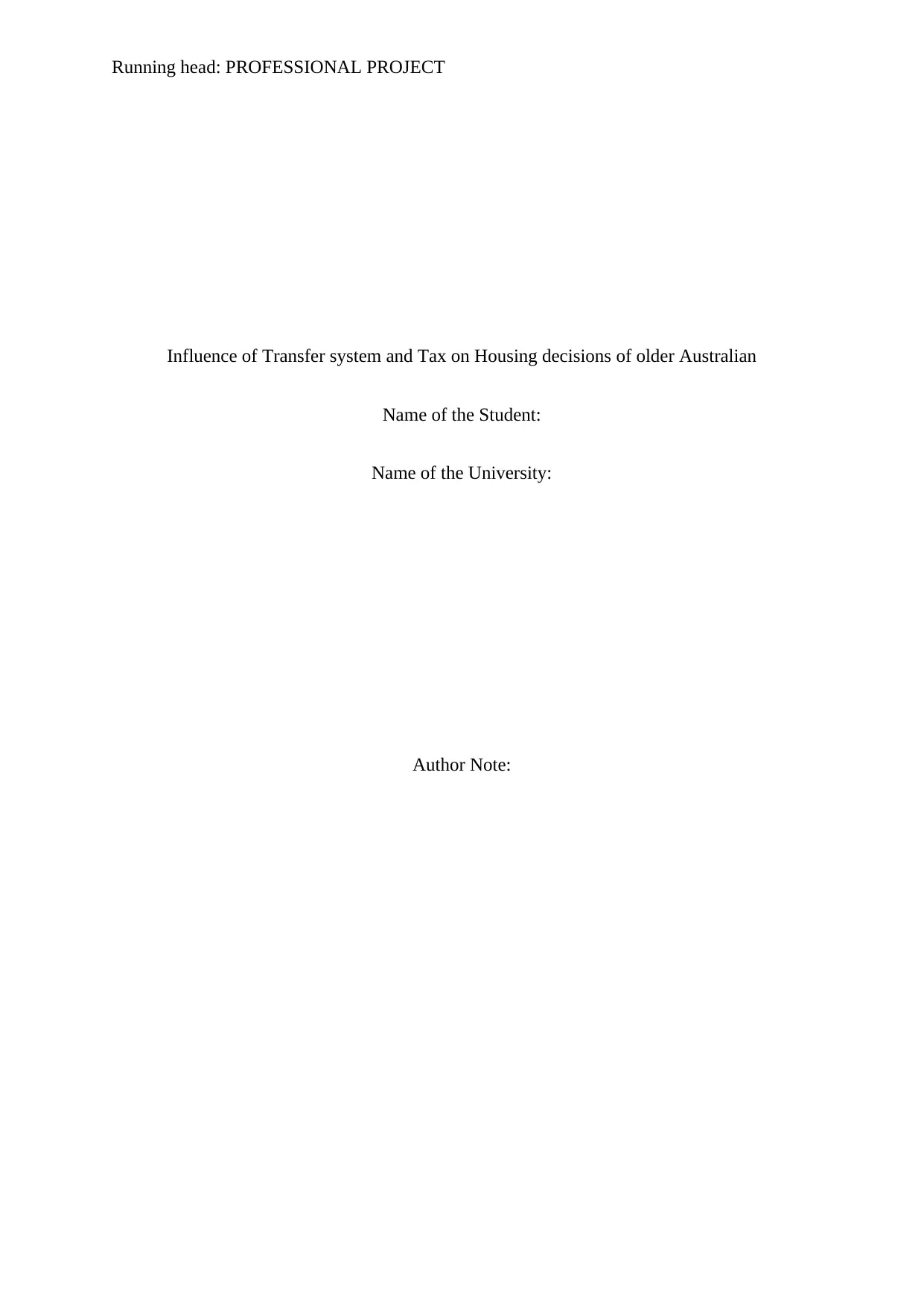
Running head: PROFESSIONAL PROJECT
Influence of Transfer system and Tax on Housing decisions of older Australian
Name of the Student:
Name of the University:
Author Note:
Influence of Transfer system and Tax on Housing decisions of older Australian
Name of the Student:
Name of the University:
Author Note:
Secure Best Marks with AI Grader
Need help grading? Try our AI Grader for instant feedback on your assignments.
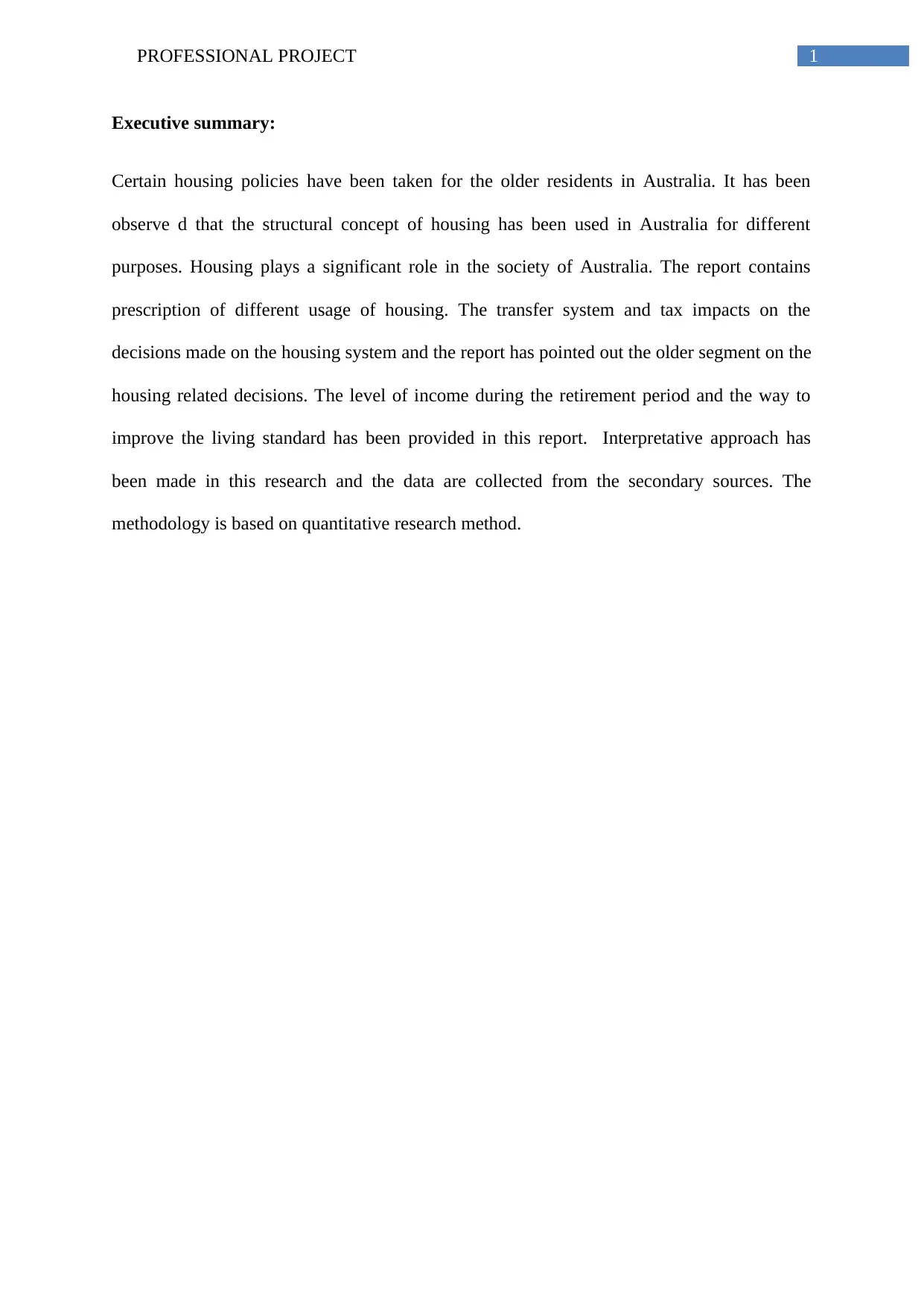
1PROFESSIONAL PROJECT
Executive summary:
Certain housing policies have been taken for the older residents in Australia. It has been
observe d that the structural concept of housing has been used in Australia for different
purposes. Housing plays a significant role in the society of Australia. The report contains
prescription of different usage of housing. The transfer system and tax impacts on the
decisions made on the housing system and the report has pointed out the older segment on the
housing related decisions. The level of income during the retirement period and the way to
improve the living standard has been provided in this report. Interpretative approach has
been made in this research and the data are collected from the secondary sources. The
methodology is based on quantitative research method.
Executive summary:
Certain housing policies have been taken for the older residents in Australia. It has been
observe d that the structural concept of housing has been used in Australia for different
purposes. Housing plays a significant role in the society of Australia. The report contains
prescription of different usage of housing. The transfer system and tax impacts on the
decisions made on the housing system and the report has pointed out the older segment on the
housing related decisions. The level of income during the retirement period and the way to
improve the living standard has been provided in this report. Interpretative approach has
been made in this research and the data are collected from the secondary sources. The
methodology is based on quantitative research method.
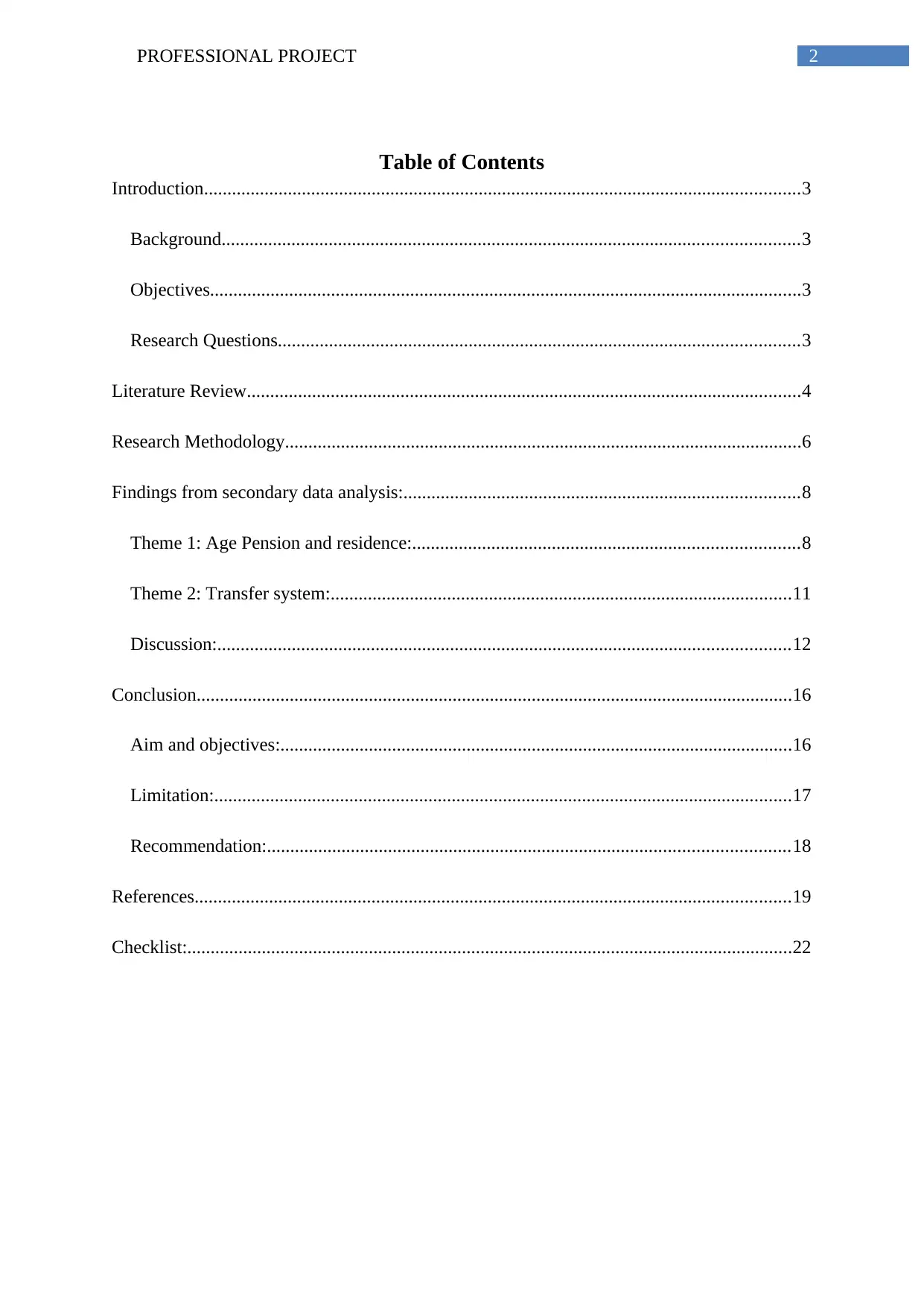
2PROFESSIONAL PROJECT
Table of Contents
Introduction................................................................................................................................3
Background............................................................................................................................3
Objectives...............................................................................................................................3
Research Questions................................................................................................................3
Literature Review.......................................................................................................................4
Research Methodology...............................................................................................................6
Findings from secondary data analysis:.....................................................................................8
Theme 1: Age Pension and residence:...................................................................................8
Theme 2: Transfer system:...................................................................................................11
Discussion:...........................................................................................................................12
Conclusion................................................................................................................................16
Aim and objectives:..............................................................................................................16
Limitation:............................................................................................................................17
Recommendation:................................................................................................................18
References................................................................................................................................19
Checklist:..................................................................................................................................22
Table of Contents
Introduction................................................................................................................................3
Background............................................................................................................................3
Objectives...............................................................................................................................3
Research Questions................................................................................................................3
Literature Review.......................................................................................................................4
Research Methodology...............................................................................................................6
Findings from secondary data analysis:.....................................................................................8
Theme 1: Age Pension and residence:...................................................................................8
Theme 2: Transfer system:...................................................................................................11
Discussion:...........................................................................................................................12
Conclusion................................................................................................................................16
Aim and objectives:..............................................................................................................16
Limitation:............................................................................................................................17
Recommendation:................................................................................................................18
References................................................................................................................................19
Checklist:..................................................................................................................................22
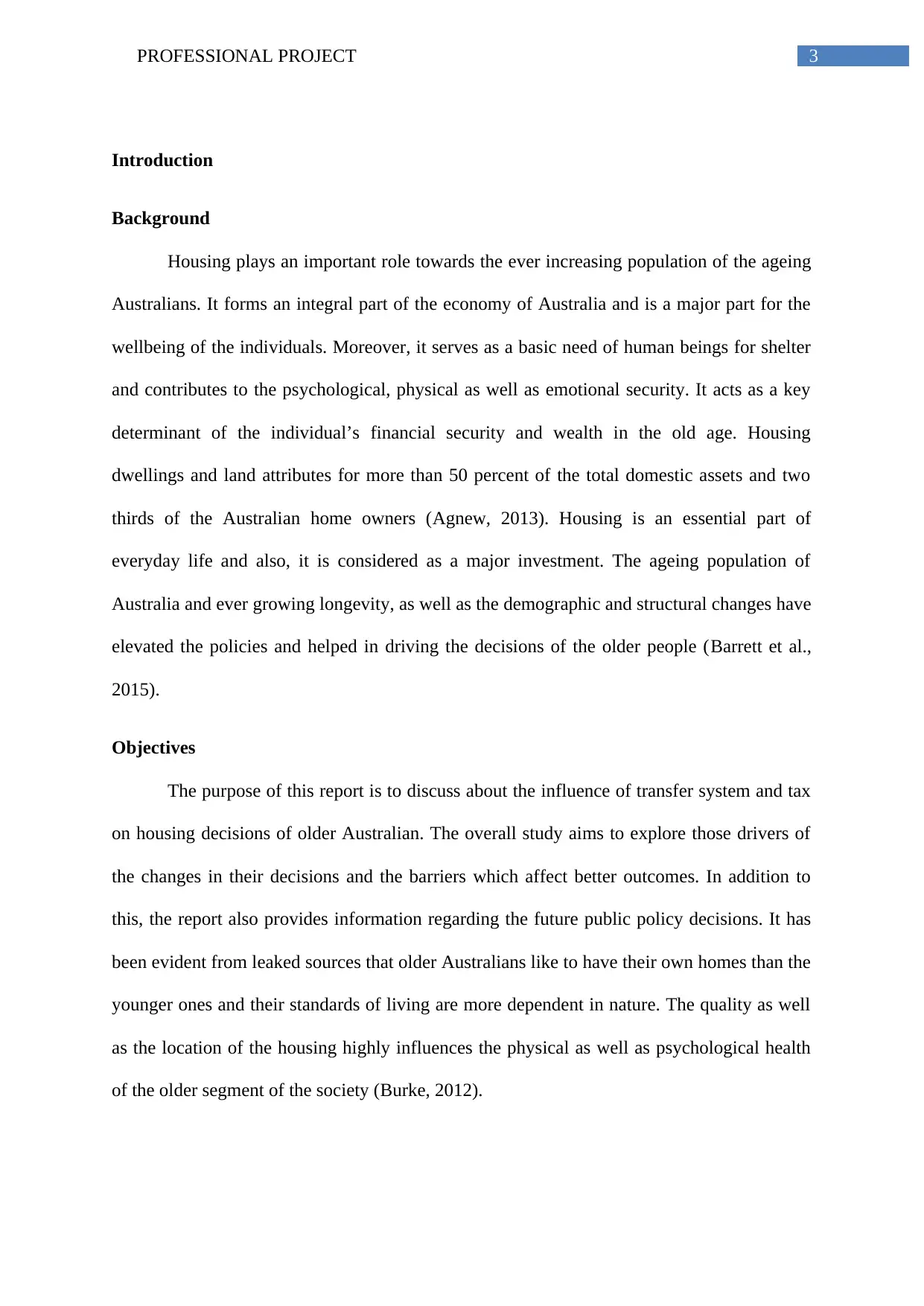
3PROFESSIONAL PROJECT
Introduction
Background
Housing plays an important role towards the ever increasing population of the ageing
Australians. It forms an integral part of the economy of Australia and is a major part for the
wellbeing of the individuals. Moreover, it serves as a basic need of human beings for shelter
and contributes to the psychological, physical as well as emotional security. It acts as a key
determinant of the individual’s financial security and wealth in the old age. Housing
dwellings and land attributes for more than 50 percent of the total domestic assets and two
thirds of the Australian home owners (Agnew, 2013). Housing is an essential part of
everyday life and also, it is considered as a major investment. The ageing population of
Australia and ever growing longevity, as well as the demographic and structural changes have
elevated the policies and helped in driving the decisions of the older people (Barrett et al.,
2015).
Objectives
The purpose of this report is to discuss about the influence of transfer system and tax
on housing decisions of older Australian. The overall study aims to explore those drivers of
the changes in their decisions and the barriers which affect better outcomes. In addition to
this, the report also provides information regarding the future public policy decisions. It has
been evident from leaked sources that older Australians like to have their own homes than the
younger ones and their standards of living are more dependent in nature. The quality as well
as the location of the housing highly influences the physical as well as psychological health
of the older segment of the society (Burke, 2012).
Introduction
Background
Housing plays an important role towards the ever increasing population of the ageing
Australians. It forms an integral part of the economy of Australia and is a major part for the
wellbeing of the individuals. Moreover, it serves as a basic need of human beings for shelter
and contributes to the psychological, physical as well as emotional security. It acts as a key
determinant of the individual’s financial security and wealth in the old age. Housing
dwellings and land attributes for more than 50 percent of the total domestic assets and two
thirds of the Australian home owners (Agnew, 2013). Housing is an essential part of
everyday life and also, it is considered as a major investment. The ageing population of
Australia and ever growing longevity, as well as the demographic and structural changes have
elevated the policies and helped in driving the decisions of the older people (Barrett et al.,
2015).
Objectives
The purpose of this report is to discuss about the influence of transfer system and tax
on housing decisions of older Australian. The overall study aims to explore those drivers of
the changes in their decisions and the barriers which affect better outcomes. In addition to
this, the report also provides information regarding the future public policy decisions. It has
been evident from leaked sources that older Australians like to have their own homes than the
younger ones and their standards of living are more dependent in nature. The quality as well
as the location of the housing highly influences the physical as well as psychological health
of the older segment of the society (Burke, 2012).
Secure Best Marks with AI Grader
Need help grading? Try our AI Grader for instant feedback on your assignments.
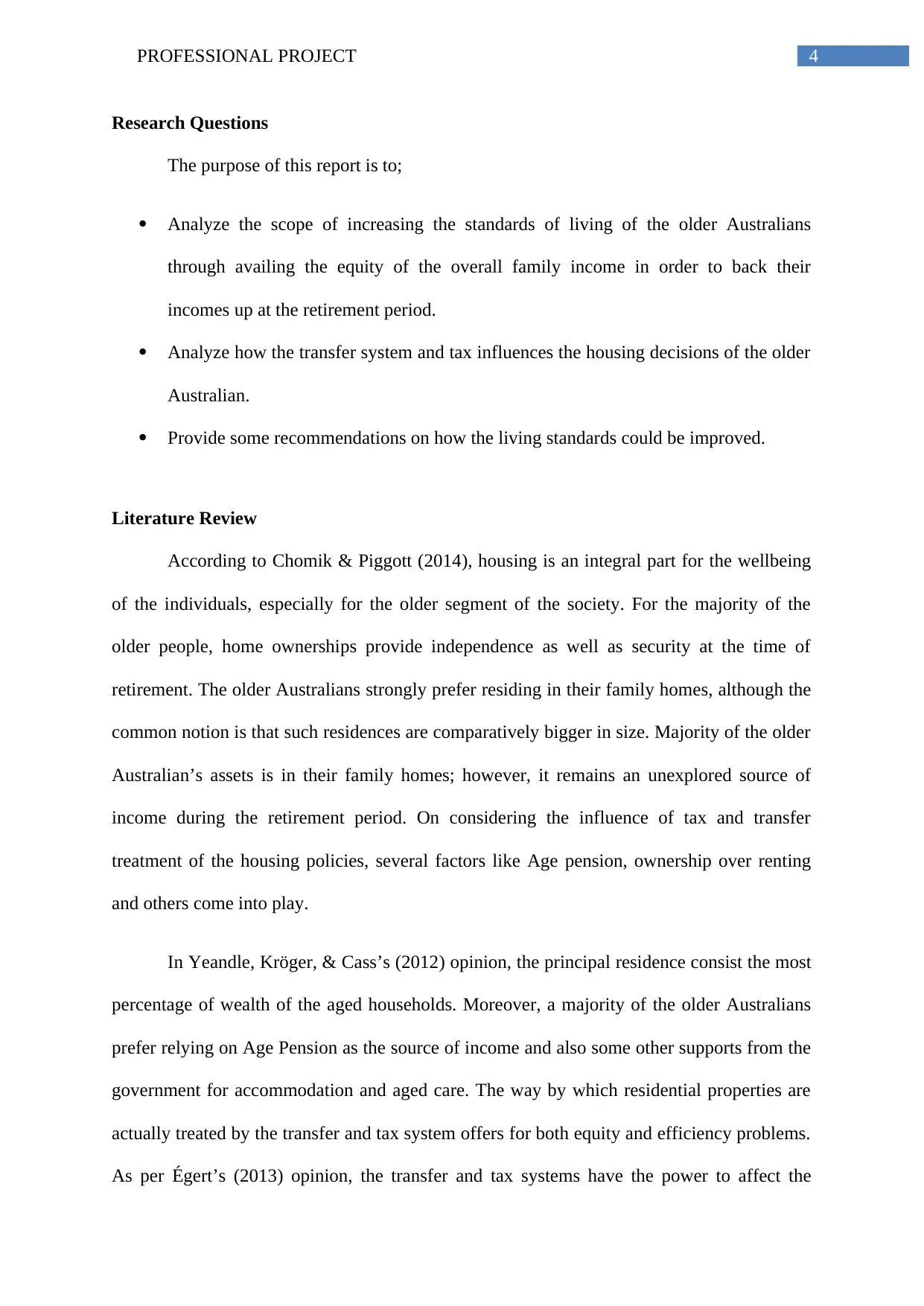
4PROFESSIONAL PROJECT
Research Questions
The purpose of this report is to;
Analyze the scope of increasing the standards of living of the older Australians
through availing the equity of the overall family income in order to back their
incomes up at the retirement period.
Analyze how the transfer system and tax influences the housing decisions of the older
Australian.
Provide some recommendations on how the living standards could be improved.
Literature Review
According to Chomik & Piggott (2014), housing is an integral part for the wellbeing
of the individuals, especially for the older segment of the society. For the majority of the
older people, home ownerships provide independence as well as security at the time of
retirement. The older Australians strongly prefer residing in their family homes, although the
common notion is that such residences are comparatively bigger in size. Majority of the older
Australian’s assets is in their family homes; however, it remains an unexplored source of
income during the retirement period. On considering the influence of tax and transfer
treatment of the housing policies, several factors like Age pension, ownership over renting
and others come into play.
In Yeandle, Kröger, & Cass’s (2012) opinion, the principal residence consist the most
percentage of wealth of the aged households. Moreover, a majority of the older Australians
prefer relying on Age Pension as the source of income and also some other supports from the
government for accommodation and aged care. The way by which residential properties are
actually treated by the transfer and tax system offers for both equity and efficiency problems.
As per Égert’s (2013) opinion, the transfer and tax systems have the power to affect the
Research Questions
The purpose of this report is to;
Analyze the scope of increasing the standards of living of the older Australians
through availing the equity of the overall family income in order to back their
incomes up at the retirement period.
Analyze how the transfer system and tax influences the housing decisions of the older
Australian.
Provide some recommendations on how the living standards could be improved.
Literature Review
According to Chomik & Piggott (2014), housing is an integral part for the wellbeing
of the individuals, especially for the older segment of the society. For the majority of the
older people, home ownerships provide independence as well as security at the time of
retirement. The older Australians strongly prefer residing in their family homes, although the
common notion is that such residences are comparatively bigger in size. Majority of the older
Australian’s assets is in their family homes; however, it remains an unexplored source of
income during the retirement period. On considering the influence of tax and transfer
treatment of the housing policies, several factors like Age pension, ownership over renting
and others come into play.
In Yeandle, Kröger, & Cass’s (2012) opinion, the principal residence consist the most
percentage of wealth of the aged households. Moreover, a majority of the older Australians
prefer relying on Age Pension as the source of income and also some other supports from the
government for accommodation and aged care. The way by which residential properties are
actually treated by the transfer and tax system offers for both equity and efficiency problems.
As per Égert’s (2013) opinion, the transfer and tax systems have the power to affect the
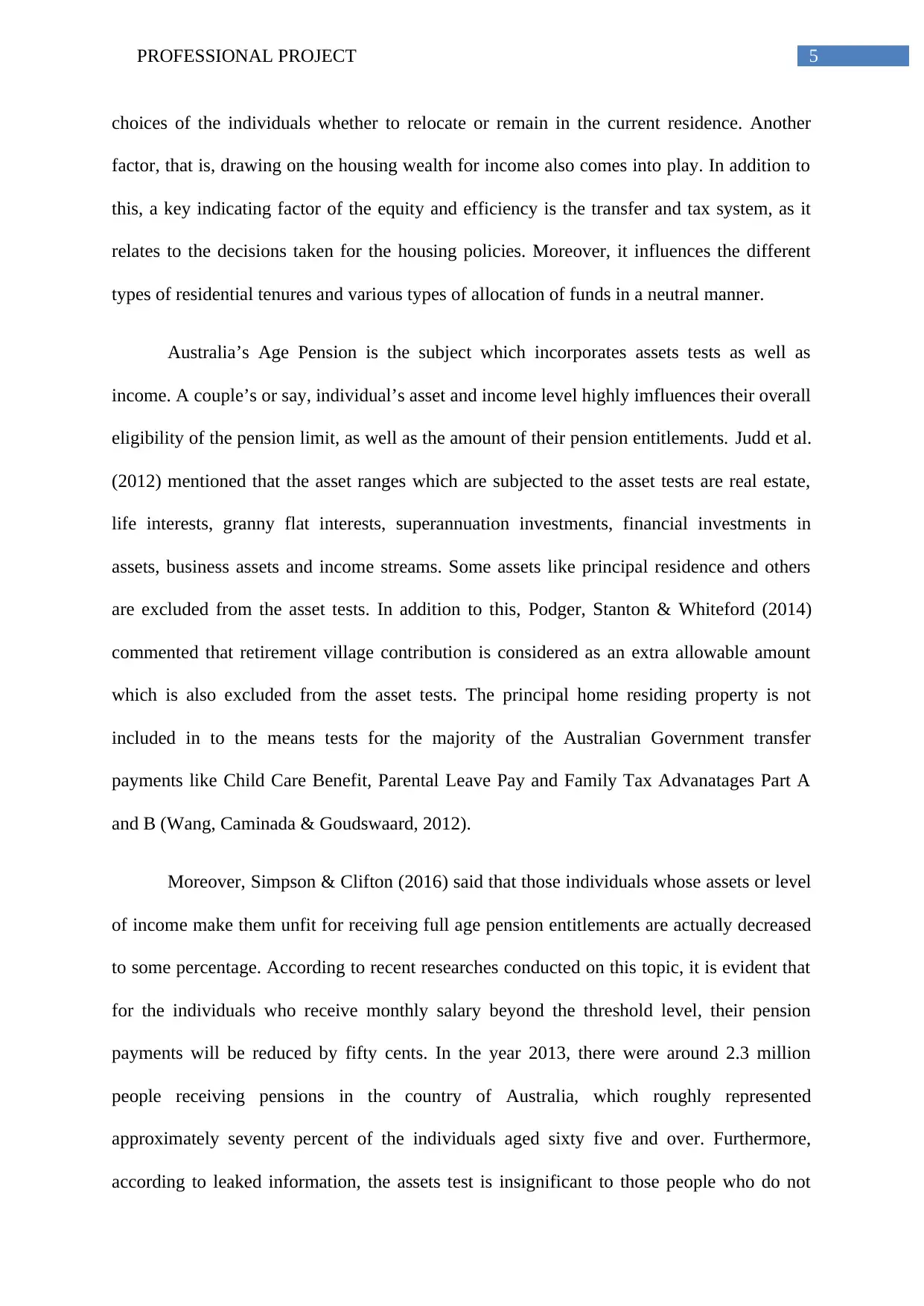
5PROFESSIONAL PROJECT
choices of the individuals whether to relocate or remain in the current residence. Another
factor, that is, drawing on the housing wealth for income also comes into play. In addition to
this, a key indicating factor of the equity and efficiency is the transfer and tax system, as it
relates to the decisions taken for the housing policies. Moreover, it influences the different
types of residential tenures and various types of allocation of funds in a neutral manner.
Australia’s Age Pension is the subject which incorporates assets tests as well as
income. A couple’s or say, individual’s asset and income level highly imfluences their overall
eligibility of the pension limit, as well as the amount of their pension entitlements. Judd et al.
(2012) mentioned that the asset ranges which are subjected to the asset tests are real estate,
life interests, granny flat interests, superannuation investments, financial investments in
assets, business assets and income streams. Some assets like principal residence and others
are excluded from the asset tests. In addition to this, Podger, Stanton & Whiteford (2014)
commented that retirement village contribution is considered as an extra allowable amount
which is also excluded from the asset tests. The principal home residing property is not
included in to the means tests for the majority of the Australian Government transfer
payments like Child Care Benefit, Parental Leave Pay and Family Tax Advanatages Part A
and B (Wang, Caminada & Goudswaard, 2012).
Moreover, Simpson & Clifton (2016) said that those individuals whose assets or level
of income make them unfit for receiving full age pension entitlements are actually decreased
to some percentage. According to recent researches conducted on this topic, it is evident that
for the individuals who receive monthly salary beyond the threshold level, their pension
payments will be reduced by fifty cents. In the year 2013, there were around 2.3 million
people receiving pensions in the country of Australia, which roughly represented
approximately seventy percent of the individuals aged sixty five and over. Furthermore,
according to leaked information, the assets test is insignificant to those people who do not
choices of the individuals whether to relocate or remain in the current residence. Another
factor, that is, drawing on the housing wealth for income also comes into play. In addition to
this, a key indicating factor of the equity and efficiency is the transfer and tax system, as it
relates to the decisions taken for the housing policies. Moreover, it influences the different
types of residential tenures and various types of allocation of funds in a neutral manner.
Australia’s Age Pension is the subject which incorporates assets tests as well as
income. A couple’s or say, individual’s asset and income level highly imfluences their overall
eligibility of the pension limit, as well as the amount of their pension entitlements. Judd et al.
(2012) mentioned that the asset ranges which are subjected to the asset tests are real estate,
life interests, granny flat interests, superannuation investments, financial investments in
assets, business assets and income streams. Some assets like principal residence and others
are excluded from the asset tests. In addition to this, Podger, Stanton & Whiteford (2014)
commented that retirement village contribution is considered as an extra allowable amount
which is also excluded from the asset tests. The principal home residing property is not
included in to the means tests for the majority of the Australian Government transfer
payments like Child Care Benefit, Parental Leave Pay and Family Tax Advanatages Part A
and B (Wang, Caminada & Goudswaard, 2012).
Moreover, Simpson & Clifton (2016) said that those individuals whose assets or level
of income make them unfit for receiving full age pension entitlements are actually decreased
to some percentage. According to recent researches conducted on this topic, it is evident that
for the individuals who receive monthly salary beyond the threshold level, their pension
payments will be reduced by fifty cents. In the year 2013, there were around 2.3 million
people receiving pensions in the country of Australia, which roughly represented
approximately seventy percent of the individuals aged sixty five and over. Furthermore,
according to leaked information, the assets test is insignificant to those people who do not
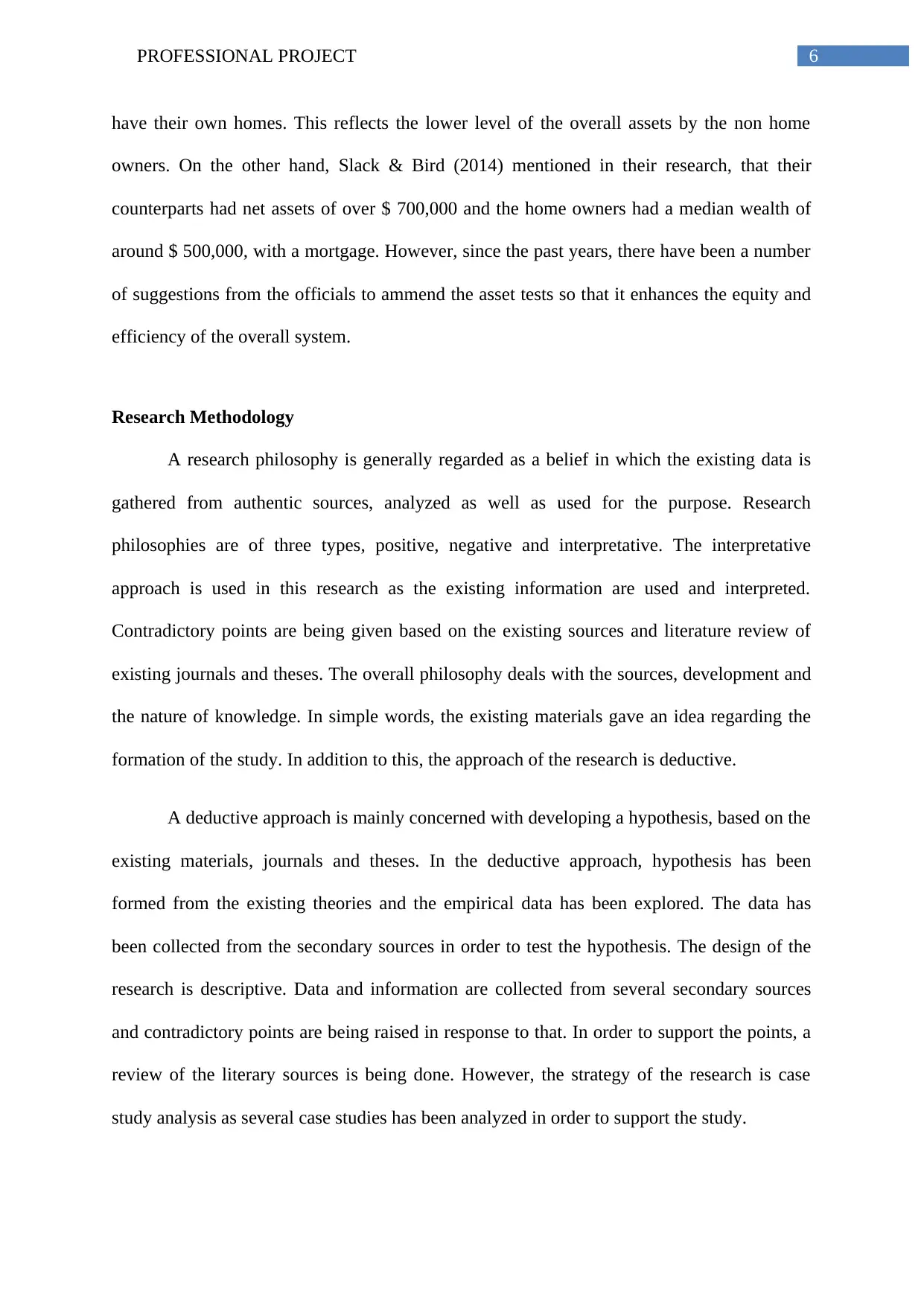
6PROFESSIONAL PROJECT
have their own homes. This reflects the lower level of the overall assets by the non home
owners. On the other hand, Slack & Bird (2014) mentioned in their research, that their
counterparts had net assets of over $ 700,000 and the home owners had a median wealth of
around $ 500,000, with a mortgage. However, since the past years, there have been a number
of suggestions from the officials to ammend the asset tests so that it enhances the equity and
efficiency of the overall system.
Research Methodology
A research philosophy is generally regarded as a belief in which the existing data is
gathered from authentic sources, analyzed as well as used for the purpose. Research
philosophies are of three types, positive, negative and interpretative. The interpretative
approach is used in this research as the existing information are used and interpreted.
Contradictory points are being given based on the existing sources and literature review of
existing journals and theses. The overall philosophy deals with the sources, development and
the nature of knowledge. In simple words, the existing materials gave an idea regarding the
formation of the study. In addition to this, the approach of the research is deductive.
A deductive approach is mainly concerned with developing a hypothesis, based on the
existing materials, journals and theses. In the deductive approach, hypothesis has been
formed from the existing theories and the empirical data has been explored. The data has
been collected from the secondary sources in order to test the hypothesis. The design of the
research is descriptive. Data and information are collected from several secondary sources
and contradictory points are being raised in response to that. In order to support the points, a
review of the literary sources is being done. However, the strategy of the research is case
study analysis as several case studies has been analyzed in order to support the study.
have their own homes. This reflects the lower level of the overall assets by the non home
owners. On the other hand, Slack & Bird (2014) mentioned in their research, that their
counterparts had net assets of over $ 700,000 and the home owners had a median wealth of
around $ 500,000, with a mortgage. However, since the past years, there have been a number
of suggestions from the officials to ammend the asset tests so that it enhances the equity and
efficiency of the overall system.
Research Methodology
A research philosophy is generally regarded as a belief in which the existing data is
gathered from authentic sources, analyzed as well as used for the purpose. Research
philosophies are of three types, positive, negative and interpretative. The interpretative
approach is used in this research as the existing information are used and interpreted.
Contradictory points are being given based on the existing sources and literature review of
existing journals and theses. The overall philosophy deals with the sources, development and
the nature of knowledge. In simple words, the existing materials gave an idea regarding the
formation of the study. In addition to this, the approach of the research is deductive.
A deductive approach is mainly concerned with developing a hypothesis, based on the
existing materials, journals and theses. In the deductive approach, hypothesis has been
formed from the existing theories and the empirical data has been explored. The data has
been collected from the secondary sources in order to test the hypothesis. The design of the
research is descriptive. Data and information are collected from several secondary sources
and contradictory points are being raised in response to that. In order to support the points, a
review of the literary sources is being done. However, the strategy of the research is case
study analysis as several case studies has been analyzed in order to support the study.
Paraphrase This Document
Need a fresh take? Get an instant paraphrase of this document with our AI Paraphraser
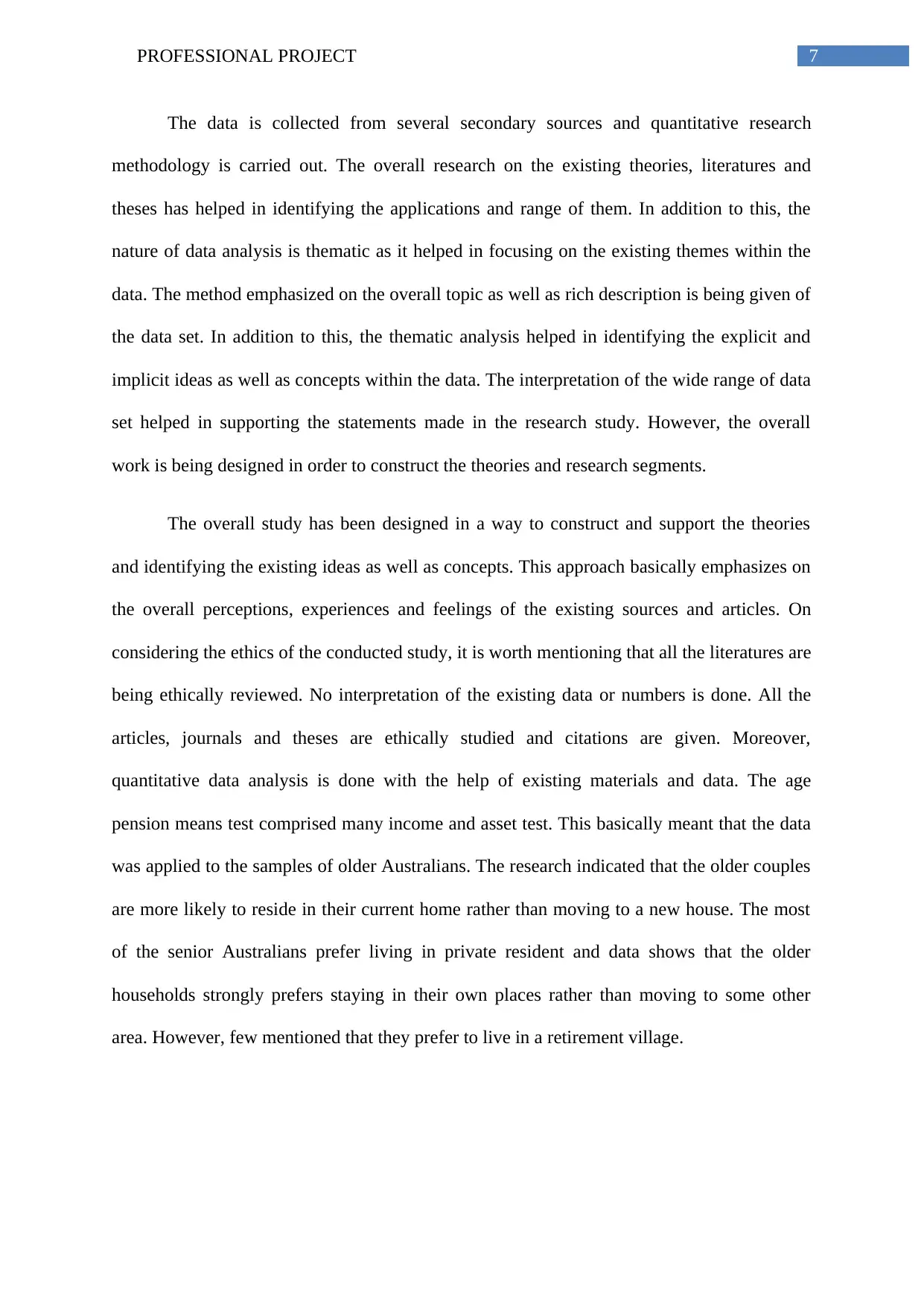
7PROFESSIONAL PROJECT
The data is collected from several secondary sources and quantitative research
methodology is carried out. The overall research on the existing theories, literatures and
theses has helped in identifying the applications and range of them. In addition to this, the
nature of data analysis is thematic as it helped in focusing on the existing themes within the
data. The method emphasized on the overall topic as well as rich description is being given of
the data set. In addition to this, the thematic analysis helped in identifying the explicit and
implicit ideas as well as concepts within the data. The interpretation of the wide range of data
set helped in supporting the statements made in the research study. However, the overall
work is being designed in order to construct the theories and research segments.
The overall study has been designed in a way to construct and support the theories
and identifying the existing ideas as well as concepts. This approach basically emphasizes on
the overall perceptions, experiences and feelings of the existing sources and articles. On
considering the ethics of the conducted study, it is worth mentioning that all the literatures are
being ethically reviewed. No interpretation of the existing data or numbers is done. All the
articles, journals and theses are ethically studied and citations are given. Moreover,
quantitative data analysis is done with the help of existing materials and data. The age
pension means test comprised many income and asset test. This basically meant that the data
was applied to the samples of older Australians. The research indicated that the older couples
are more likely to reside in their current home rather than moving to a new house. The most
of the senior Australians prefer living in private resident and data shows that the older
households strongly prefers staying in their own places rather than moving to some other
area. However, few mentioned that they prefer to live in a retirement village.
The data is collected from several secondary sources and quantitative research
methodology is carried out. The overall research on the existing theories, literatures and
theses has helped in identifying the applications and range of them. In addition to this, the
nature of data analysis is thematic as it helped in focusing on the existing themes within the
data. The method emphasized on the overall topic as well as rich description is being given of
the data set. In addition to this, the thematic analysis helped in identifying the explicit and
implicit ideas as well as concepts within the data. The interpretation of the wide range of data
set helped in supporting the statements made in the research study. However, the overall
work is being designed in order to construct the theories and research segments.
The overall study has been designed in a way to construct and support the theories
and identifying the existing ideas as well as concepts. This approach basically emphasizes on
the overall perceptions, experiences and feelings of the existing sources and articles. On
considering the ethics of the conducted study, it is worth mentioning that all the literatures are
being ethically reviewed. No interpretation of the existing data or numbers is done. All the
articles, journals and theses are ethically studied and citations are given. Moreover,
quantitative data analysis is done with the help of existing materials and data. The age
pension means test comprised many income and asset test. This basically meant that the data
was applied to the samples of older Australians. The research indicated that the older couples
are more likely to reside in their current home rather than moving to a new house. The most
of the senior Australians prefer living in private resident and data shows that the older
households strongly prefers staying in their own places rather than moving to some other
area. However, few mentioned that they prefer to live in a retirement village.
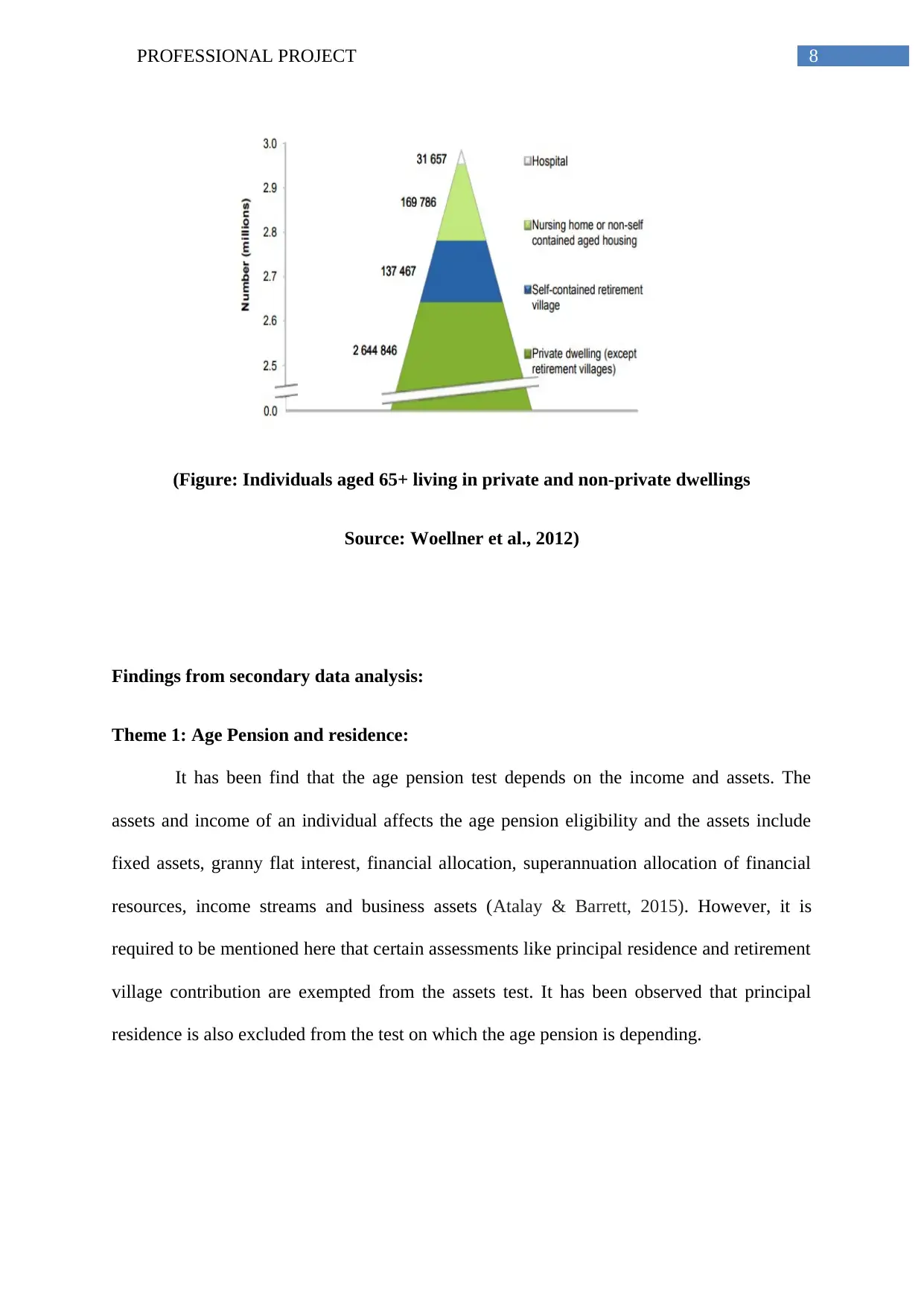
8PROFESSIONAL PROJECT
(Figure: Individuals aged 65+ living in private and non-private dwellings
Source: Woellner et al., 2012)
Findings from secondary data analysis:
Theme 1: Age Pension and residence:
It has been find that the age pension test depends on the income and assets. The
assets and income of an individual affects the age pension eligibility and the assets include
fixed assets, granny flat interest, financial allocation, superannuation allocation of financial
resources, income streams and business assets (Atalay & Barrett, 2015). However, it is
required to be mentioned here that certain assessments like principal residence and retirement
village contribution are exempted from the assets test. It has been observed that principal
residence is also excluded from the test on which the age pension is depending.
(Figure: Individuals aged 65+ living in private and non-private dwellings
Source: Woellner et al., 2012)
Findings from secondary data analysis:
Theme 1: Age Pension and residence:
It has been find that the age pension test depends on the income and assets. The
assets and income of an individual affects the age pension eligibility and the assets include
fixed assets, granny flat interest, financial allocation, superannuation allocation of financial
resources, income streams and business assets (Atalay & Barrett, 2015). However, it is
required to be mentioned here that certain assessments like principal residence and retirement
village contribution are exempted from the assets test. It has been observed that principal
residence is also excluded from the test on which the age pension is depending.
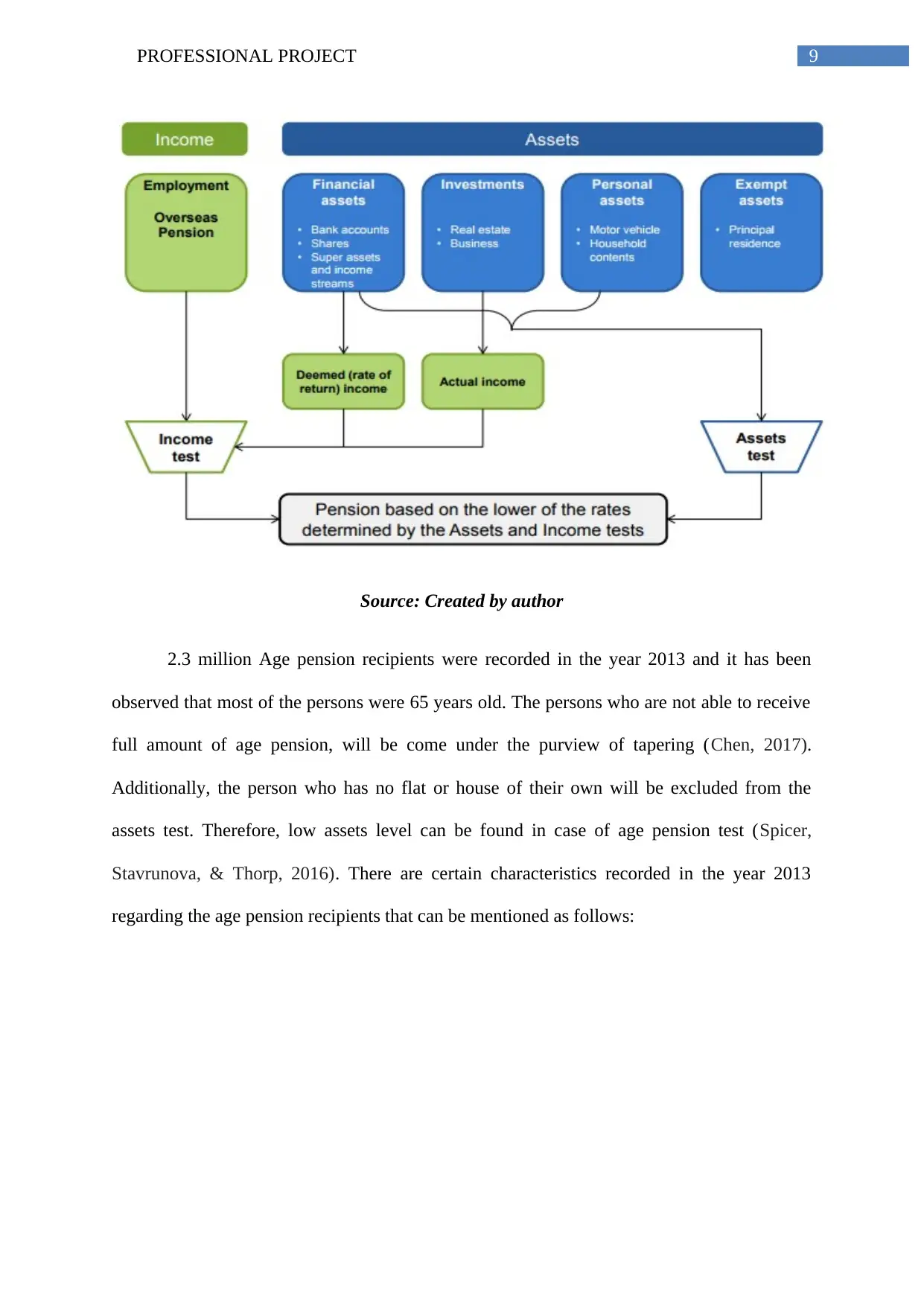
9PROFESSIONAL PROJECT
Source: Created by author
2.3 million Age pension recipients were recorded in the year 2013 and it has been
observed that most of the persons were 65 years old. The persons who are not able to receive
full amount of age pension, will be come under the purview of tapering (Chen, 2017).
Additionally, the person who has no flat or house of their own will be excluded from the
assets test. Therefore, low assets level can be found in case of age pension test (Spicer,
Stavrunova, & Thorp, 2016). There are certain characteristics recorded in the year 2013
regarding the age pension recipients that can be mentioned as follows:
Source: Created by author
2.3 million Age pension recipients were recorded in the year 2013 and it has been
observed that most of the persons were 65 years old. The persons who are not able to receive
full amount of age pension, will be come under the purview of tapering (Chen, 2017).
Additionally, the person who has no flat or house of their own will be excluded from the
assets test. Therefore, low assets level can be found in case of age pension test (Spicer,
Stavrunova, & Thorp, 2016). There are certain characteristics recorded in the year 2013
regarding the age pension recipients that can be mentioned as follows:
Secure Best Marks with AI Grader
Need help grading? Try our AI Grader for instant feedback on your assignments.
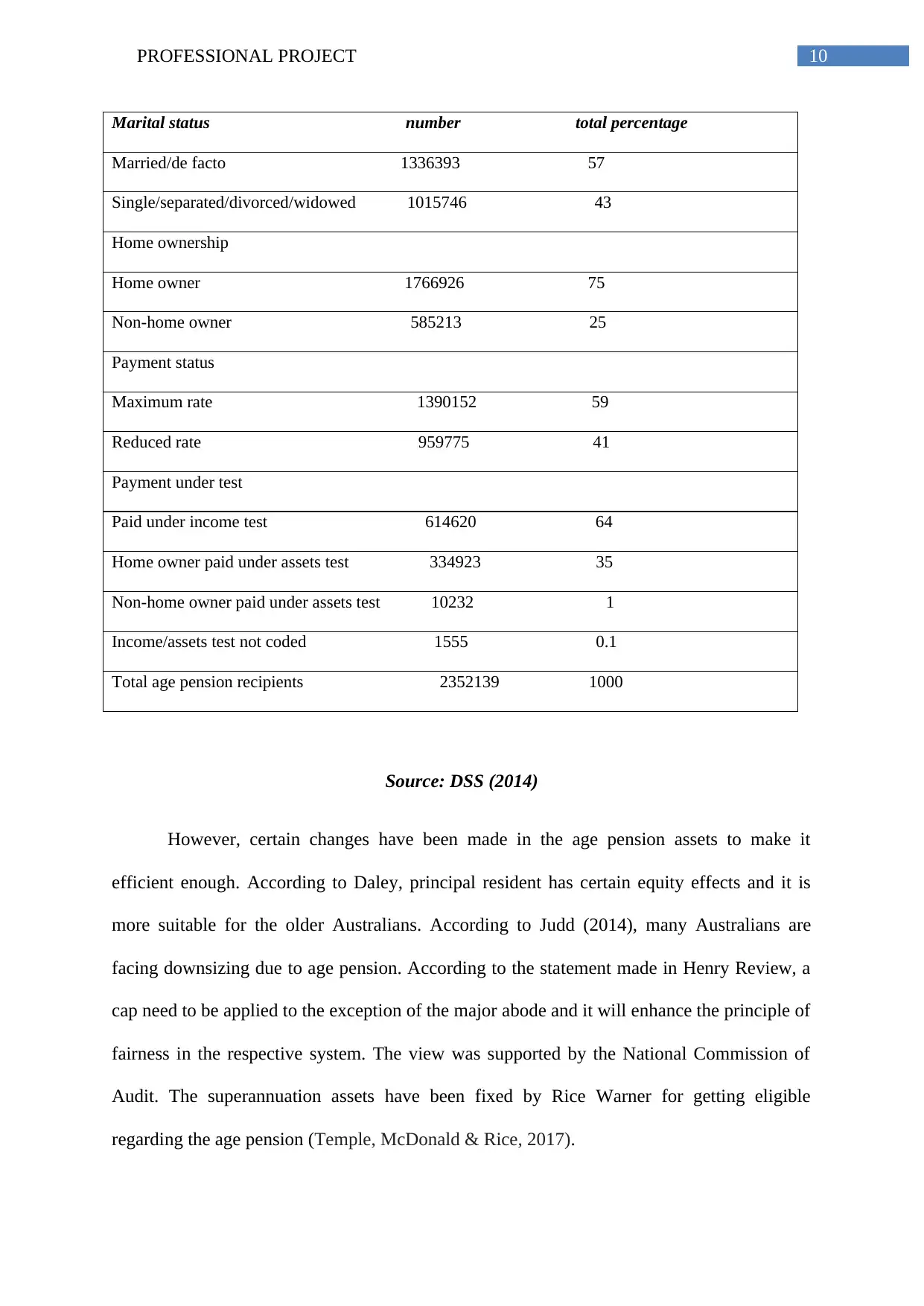
10PROFESSIONAL PROJECT
Marital status number total percentage
Married/de facto 1336393 57
Single/separated/divorced/widowed 1015746 43
Home ownership
Home owner 1766926 75
Non-home owner 585213 25
Payment status
Maximum rate 1390152 59
Reduced rate 959775 41
Payment under test
Paid under income test 614620 64
Home owner paid under assets test 334923 35
Non-home owner paid under assets test 10232 1
Income/assets test not coded 1555 0.1
Total age pension recipients 2352139 1000
Source: DSS (2014)
However, certain changes have been made in the age pension assets to make it
efficient enough. According to Daley, principal resident has certain equity effects and it is
more suitable for the older Australians. According to Judd (2014), many Australians are
facing downsizing due to age pension. According to the statement made in Henry Review, a
cap need to be applied to the exception of the major abode and it will enhance the principle of
fairness in the respective system. The view was supported by the National Commission of
Audit. The superannuation assets have been fixed by Rice Warner for getting eligible
regarding the age pension (Temple, McDonald & Rice, 2017).
Marital status number total percentage
Married/de facto 1336393 57
Single/separated/divorced/widowed 1015746 43
Home ownership
Home owner 1766926 75
Non-home owner 585213 25
Payment status
Maximum rate 1390152 59
Reduced rate 959775 41
Payment under test
Paid under income test 614620 64
Home owner paid under assets test 334923 35
Non-home owner paid under assets test 10232 1
Income/assets test not coded 1555 0.1
Total age pension recipients 2352139 1000
Source: DSS (2014)
However, certain changes have been made in the age pension assets to make it
efficient enough. According to Daley, principal resident has certain equity effects and it is
more suitable for the older Australians. According to Judd (2014), many Australians are
facing downsizing due to age pension. According to the statement made in Henry Review, a
cap need to be applied to the exception of the major abode and it will enhance the principle of
fairness in the respective system. The view was supported by the National Commission of
Audit. The superannuation assets have been fixed by Rice Warner for getting eligible
regarding the age pension (Temple, McDonald & Rice, 2017).
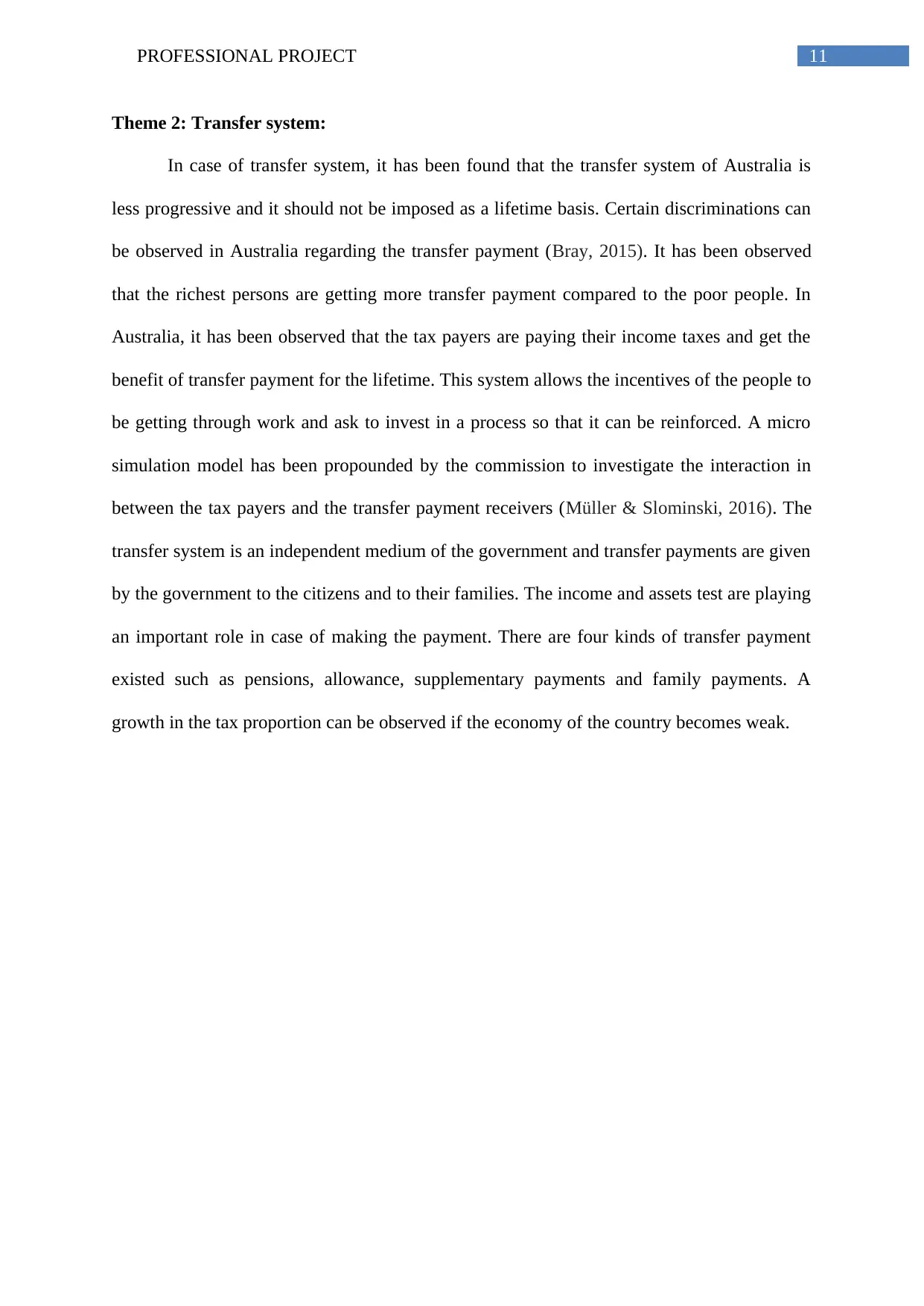
11PROFESSIONAL PROJECT
Theme 2: Transfer system:
In case of transfer system, it has been found that the transfer system of Australia is
less progressive and it should not be imposed as a lifetime basis. Certain discriminations can
be observed in Australia regarding the transfer payment (Bray, 2015). It has been observed
that the richest persons are getting more transfer payment compared to the poor people. In
Australia, it has been observed that the tax payers are paying their income taxes and get the
benefit of transfer payment for the lifetime. This system allows the incentives of the people to
be getting through work and ask to invest in a process so that it can be reinforced. A micro
simulation model has been propounded by the commission to investigate the interaction in
between the tax payers and the transfer payment receivers (Müller & Slominski, 2016). The
transfer system is an independent medium of the government and transfer payments are given
by the government to the citizens and to their families. The income and assets test are playing
an important role in case of making the payment. There are four kinds of transfer payment
existed such as pensions, allowance, supplementary payments and family payments. A
growth in the tax proportion can be observed if the economy of the country becomes weak.
Theme 2: Transfer system:
In case of transfer system, it has been found that the transfer system of Australia is
less progressive and it should not be imposed as a lifetime basis. Certain discriminations can
be observed in Australia regarding the transfer payment (Bray, 2015). It has been observed
that the richest persons are getting more transfer payment compared to the poor people. In
Australia, it has been observed that the tax payers are paying their income taxes and get the
benefit of transfer payment for the lifetime. This system allows the incentives of the people to
be getting through work and ask to invest in a process so that it can be reinforced. A micro
simulation model has been propounded by the commission to investigate the interaction in
between the tax payers and the transfer payment receivers (Müller & Slominski, 2016). The
transfer system is an independent medium of the government and transfer payments are given
by the government to the citizens and to their families. The income and assets test are playing
an important role in case of making the payment. There are four kinds of transfer payment
existed such as pensions, allowance, supplementary payments and family payments. A
growth in the tax proportion can be observed if the economy of the country becomes weak.
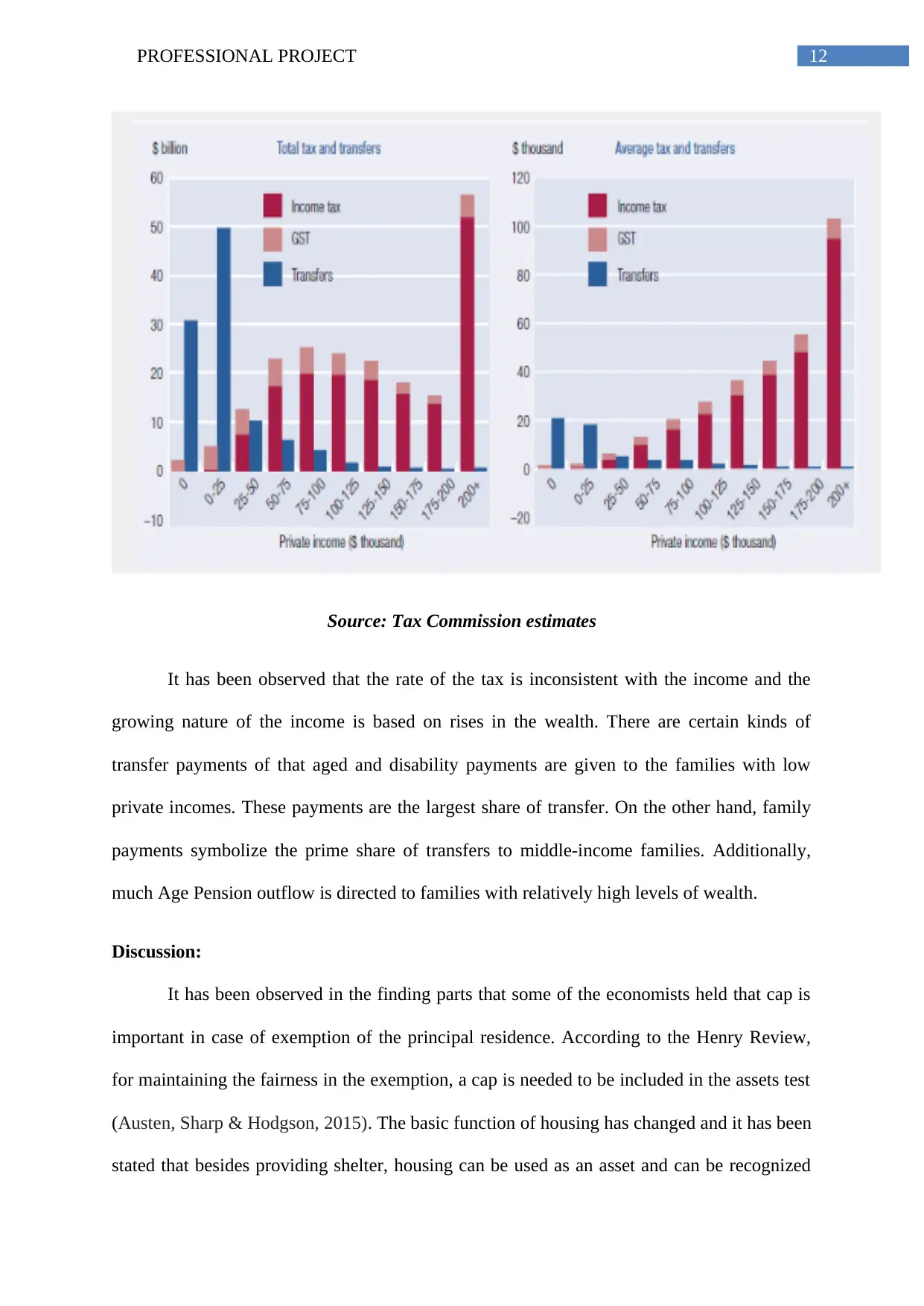
12PROFESSIONAL PROJECT
Source: Tax Commission estimates
It has been observed that the rate of the tax is inconsistent with the income and the
growing nature of the income is based on rises in the wealth. There are certain kinds of
transfer payments of that aged and disability payments are given to the families with low
private incomes. These payments are the largest share of transfer. On the other hand, family
payments symbolize the prime share of transfers to middle-income families. Additionally,
much Age Pension outflow is directed to families with relatively high levels of wealth.
Discussion:
It has been observed in the finding parts that some of the economists held that cap is
important in case of exemption of the principal residence. According to the Henry Review,
for maintaining the fairness in the exemption, a cap is needed to be included in the assets test
(Austen, Sharp & Hodgson, 2015). The basic function of housing has changed and it has been
stated that besides providing shelter, housing can be used as an asset and can be recognized
Source: Tax Commission estimates
It has been observed that the rate of the tax is inconsistent with the income and the
growing nature of the income is based on rises in the wealth. There are certain kinds of
transfer payments of that aged and disability payments are given to the families with low
private incomes. These payments are the largest share of transfer. On the other hand, family
payments symbolize the prime share of transfers to middle-income families. Additionally,
much Age Pension outflow is directed to families with relatively high levels of wealth.
Discussion:
It has been observed in the finding parts that some of the economists held that cap is
important in case of exemption of the principal residence. According to the Henry Review,
for maintaining the fairness in the exemption, a cap is needed to be included in the assets test
(Austen, Sharp & Hodgson, 2015). The basic function of housing has changed and it has been
stated that besides providing shelter, housing can be used as an asset and can be recognized
Paraphrase This Document
Need a fresh take? Get an instant paraphrase of this document with our AI Paraphraser
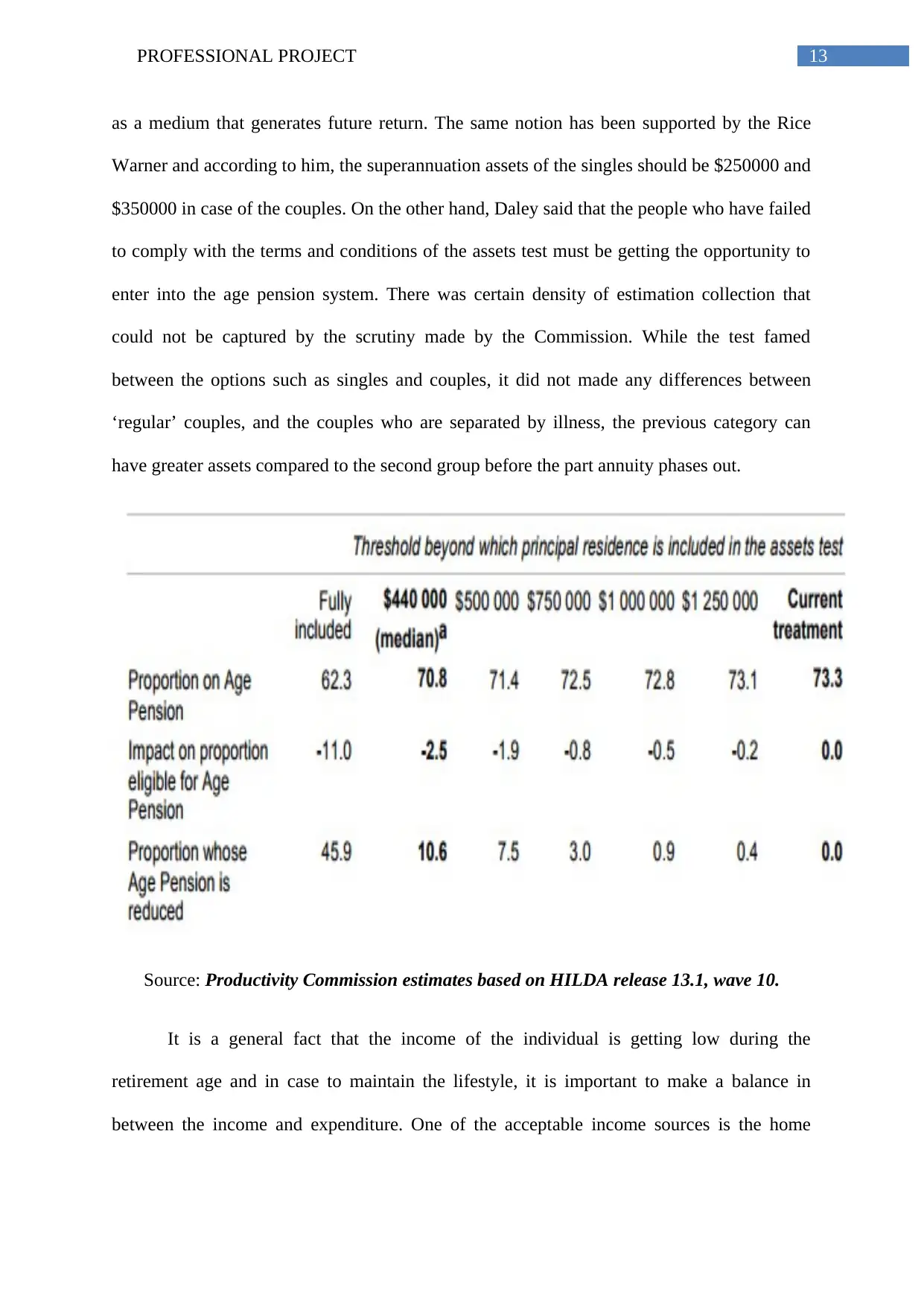
13PROFESSIONAL PROJECT
as a medium that generates future return. The same notion has been supported by the Rice
Warner and according to him, the superannuation assets of the singles should be $250000 and
$350000 in case of the couples. On the other hand, Daley said that the people who have failed
to comply with the terms and conditions of the assets test must be getting the opportunity to
enter into the age pension system. There was certain density of estimation collection that
could not be captured by the scrutiny made by the Commission. While the test famed
between the options such as singles and couples, it did not made any differences between
‘regular’ couples, and the couples who are separated by illness, the previous category can
have greater assets compared to the second group before the part annuity phases out.
Source: Productivity Commission estimates based on HILDA release 13.1, wave 10.
It is a general fact that the income of the individual is getting low during the
retirement age and in case to maintain the lifestyle, it is important to make a balance in
between the income and expenditure. One of the acceptable income sources is the home
as a medium that generates future return. The same notion has been supported by the Rice
Warner and according to him, the superannuation assets of the singles should be $250000 and
$350000 in case of the couples. On the other hand, Daley said that the people who have failed
to comply with the terms and conditions of the assets test must be getting the opportunity to
enter into the age pension system. There was certain density of estimation collection that
could not be captured by the scrutiny made by the Commission. While the test famed
between the options such as singles and couples, it did not made any differences between
‘regular’ couples, and the couples who are separated by illness, the previous category can
have greater assets compared to the second group before the part annuity phases out.
Source: Productivity Commission estimates based on HILDA release 13.1, wave 10.
It is a general fact that the income of the individual is getting low during the
retirement age and in case to maintain the lifestyle, it is important to make a balance in
between the income and expenditure. One of the acceptable income sources is the home
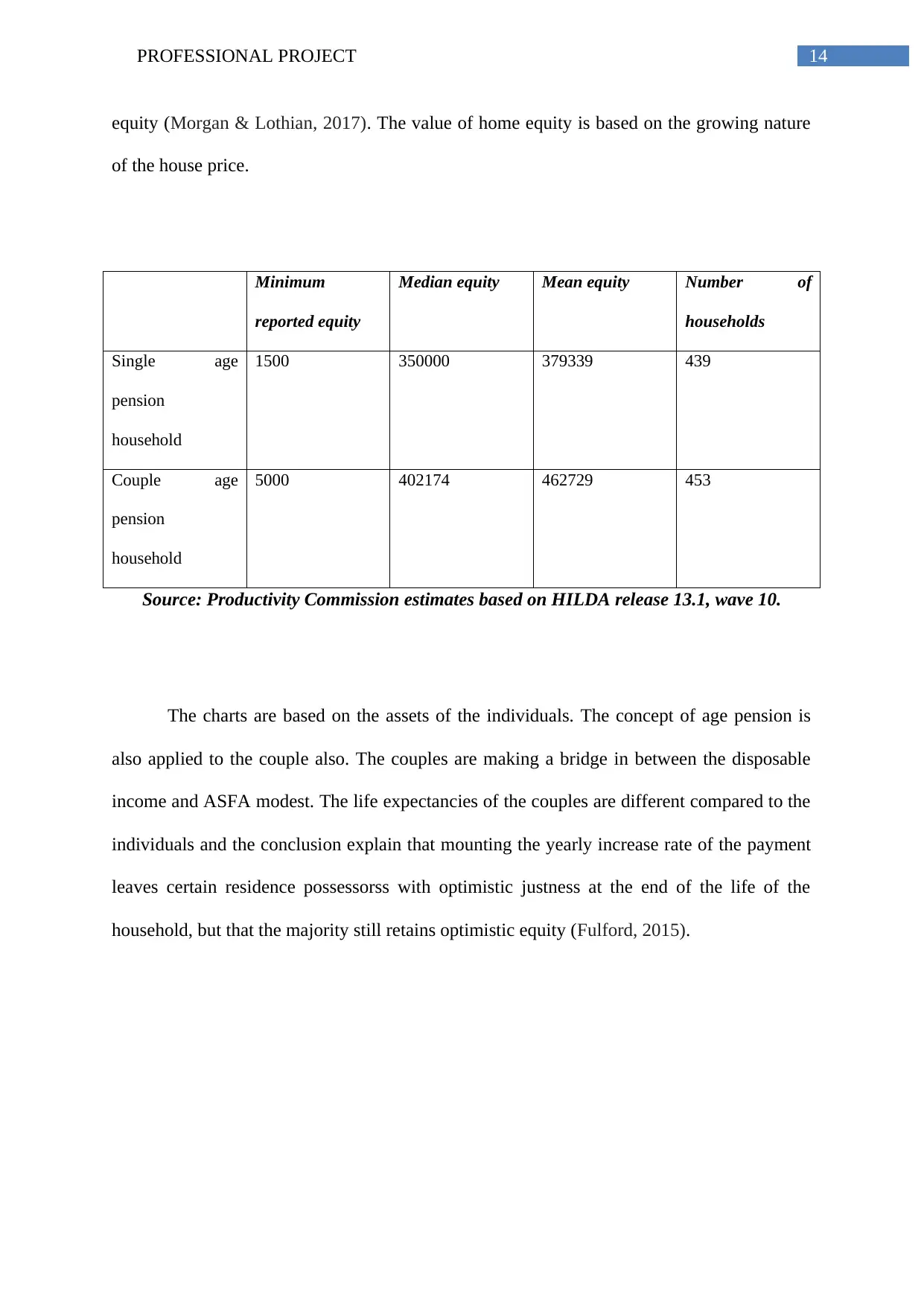
14PROFESSIONAL PROJECT
equity (Morgan & Lothian, 2017). The value of home equity is based on the growing nature
of the house price.
Minimum
reported equity
Median equity Mean equity Number of
households
Single age
pension
household
1500 350000 379339 439
Couple age
pension
household
5000 402174 462729 453
Source: Productivity Commission estimates based on HILDA release 13.1, wave 10.
The charts are based on the assets of the individuals. The concept of age pension is
also applied to the couple also. The couples are making a bridge in between the disposable
income and ASFA modest. The life expectancies of the couples are different compared to the
individuals and the conclusion explain that mounting the yearly increase rate of the payment
leaves certain residence possessorss with optimistic justness at the end of the life of the
household, but that the majority still retains optimistic equity (Fulford, 2015).
equity (Morgan & Lothian, 2017). The value of home equity is based on the growing nature
of the house price.
Minimum
reported equity
Median equity Mean equity Number of
households
Single age
pension
household
1500 350000 379339 439
Couple age
pension
household
5000 402174 462729 453
Source: Productivity Commission estimates based on HILDA release 13.1, wave 10.
The charts are based on the assets of the individuals. The concept of age pension is
also applied to the couple also. The couples are making a bridge in between the disposable
income and ASFA modest. The life expectancies of the couples are different compared to the
individuals and the conclusion explain that mounting the yearly increase rate of the payment
leaves certain residence possessorss with optimistic justness at the end of the life of the
household, but that the majority still retains optimistic equity (Fulford, 2015).
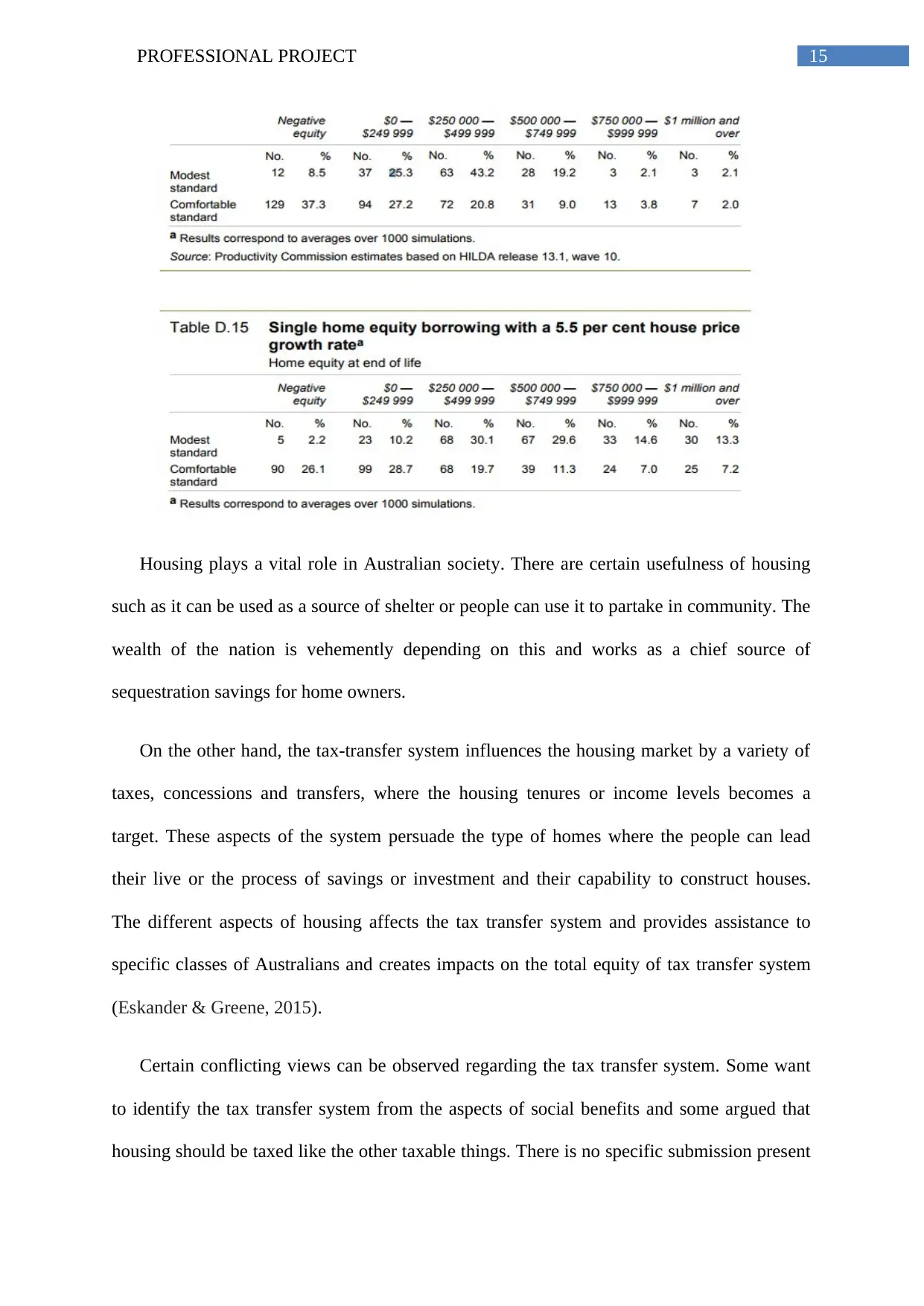
15PROFESSIONAL PROJECT
Housing plays a vital role in Australian society. There are certain usefulness of housing
such as it can be used as a source of shelter or people can use it to partake in community. The
wealth of the nation is vehemently depending on this and works as a chief source of
sequestration savings for home owners.
On the other hand, the tax-transfer system influences the housing market by a variety of
taxes, concessions and transfers, where the housing tenures or income levels becomes a
target. These aspects of the system persuade the type of homes where the people can lead
their live or the process of savings or investment and their capability to construct houses.
The different aspects of housing affects the tax transfer system and provides assistance to
specific classes of Australians and creates impacts on the total equity of tax transfer system
(Eskander & Greene, 2015).
Certain conflicting views can be observed regarding the tax transfer system. Some want
to identify the tax transfer system from the aspects of social benefits and some argued that
housing should be taxed like the other taxable things. There is no specific submission present
Housing plays a vital role in Australian society. There are certain usefulness of housing
such as it can be used as a source of shelter or people can use it to partake in community. The
wealth of the nation is vehemently depending on this and works as a chief source of
sequestration savings for home owners.
On the other hand, the tax-transfer system influences the housing market by a variety of
taxes, concessions and transfers, where the housing tenures or income levels becomes a
target. These aspects of the system persuade the type of homes where the people can lead
their live or the process of savings or investment and their capability to construct houses.
The different aspects of housing affects the tax transfer system and provides assistance to
specific classes of Australians and creates impacts on the total equity of tax transfer system
(Eskander & Greene, 2015).
Certain conflicting views can be observed regarding the tax transfer system. Some want
to identify the tax transfer system from the aspects of social benefits and some argued that
housing should be taxed like the other taxable things. There is no specific submission present
Secure Best Marks with AI Grader
Need help grading? Try our AI Grader for instant feedback on your assignments.
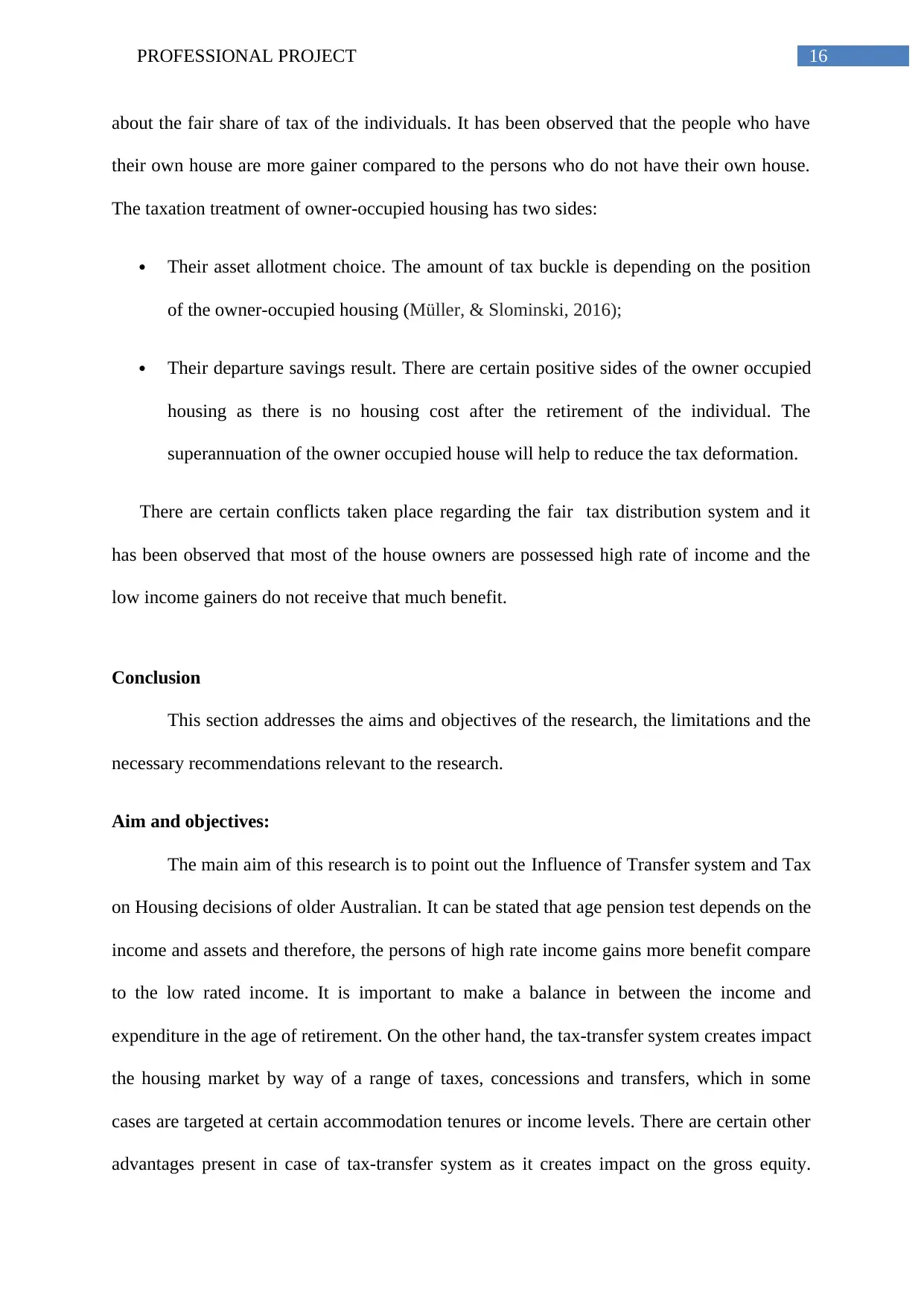
16PROFESSIONAL PROJECT
about the fair share of tax of the individuals. It has been observed that the people who have
their own house are more gainer compared to the persons who do not have their own house.
The taxation treatment of owner-occupied housing has two sides:
Their asset allotment choice. The amount of tax buckle is depending on the position
of the owner-occupied housing (Müller, & Slominski, 2016);
Their departure savings result. There are certain positive sides of the owner occupied
housing as there is no housing cost after the retirement of the individual. The
superannuation of the owner occupied house will help to reduce the tax deformation.
There are certain conflicts taken place regarding the fair tax distribution system and it
has been observed that most of the house owners are possessed high rate of income and the
low income gainers do not receive that much benefit.
Conclusion
This section addresses the aims and objectives of the research, the limitations and the
necessary recommendations relevant to the research.
Aim and objectives:
The main aim of this research is to point out the Influence of Transfer system and Tax
on Housing decisions of older Australian. It can be stated that age pension test depends on the
income and assets and therefore, the persons of high rate income gains more benefit compare
to the low rated income. It is important to make a balance in between the income and
expenditure in the age of retirement. On the other hand, the tax-transfer system creates impact
the housing market by way of a range of taxes, concessions and transfers, which in some
cases are targeted at certain accommodation tenures or income levels. There are certain other
advantages present in case of tax-transfer system as it creates impact on the gross equity.
about the fair share of tax of the individuals. It has been observed that the people who have
their own house are more gainer compared to the persons who do not have their own house.
The taxation treatment of owner-occupied housing has two sides:
Their asset allotment choice. The amount of tax buckle is depending on the position
of the owner-occupied housing (Müller, & Slominski, 2016);
Their departure savings result. There are certain positive sides of the owner occupied
housing as there is no housing cost after the retirement of the individual. The
superannuation of the owner occupied house will help to reduce the tax deformation.
There are certain conflicts taken place regarding the fair tax distribution system and it
has been observed that most of the house owners are possessed high rate of income and the
low income gainers do not receive that much benefit.
Conclusion
This section addresses the aims and objectives of the research, the limitations and the
necessary recommendations relevant to the research.
Aim and objectives:
The main aim of this research is to point out the Influence of Transfer system and Tax
on Housing decisions of older Australian. It can be stated that age pension test depends on the
income and assets and therefore, the persons of high rate income gains more benefit compare
to the low rated income. It is important to make a balance in between the income and
expenditure in the age of retirement. On the other hand, the tax-transfer system creates impact
the housing market by way of a range of taxes, concessions and transfers, which in some
cases are targeted at certain accommodation tenures or income levels. There are certain other
advantages present in case of tax-transfer system as it creates impact on the gross equity.
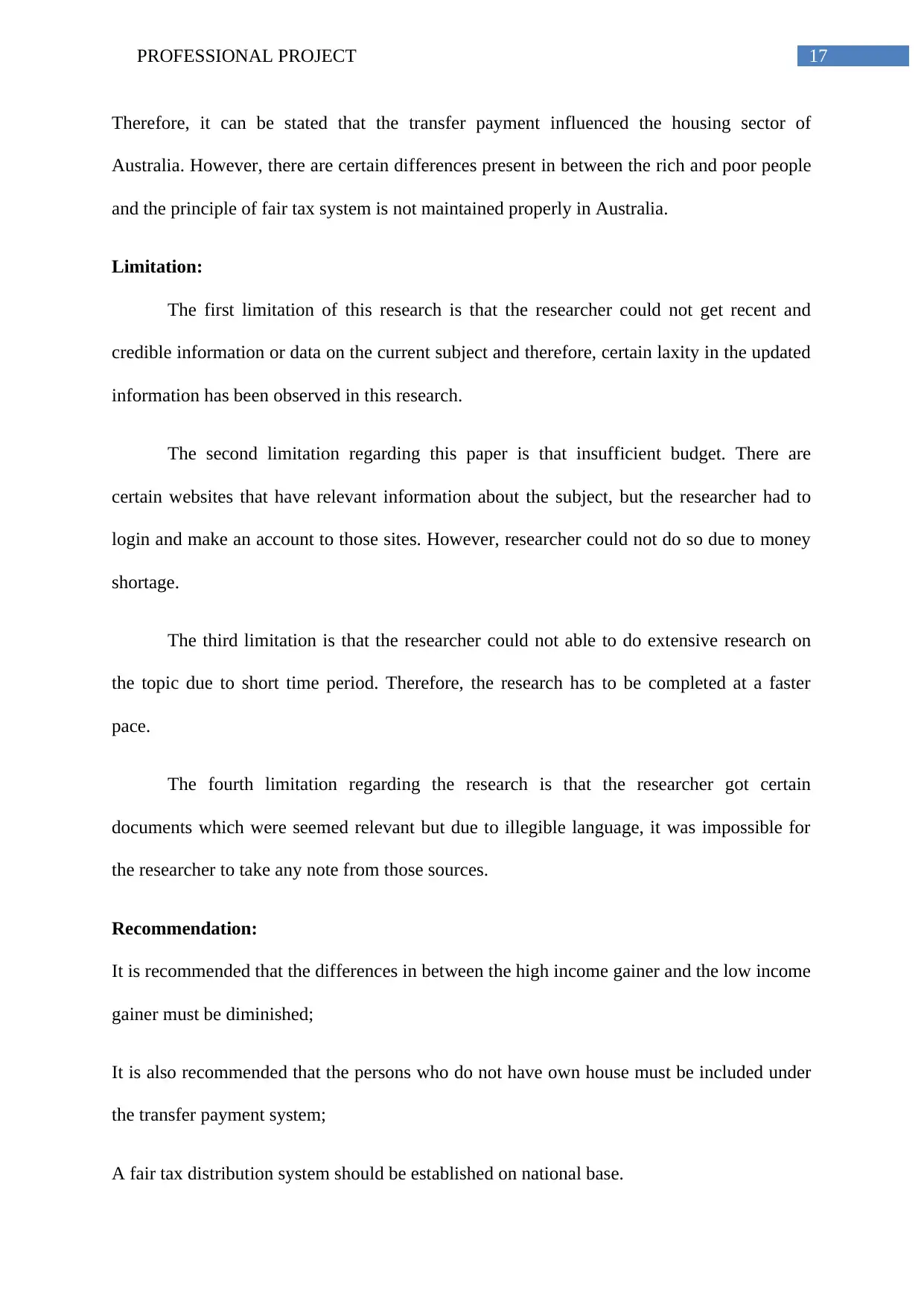
17PROFESSIONAL PROJECT
Therefore, it can be stated that the transfer payment influenced the housing sector of
Australia. However, there are certain differences present in between the rich and poor people
and the principle of fair tax system is not maintained properly in Australia.
Limitation:
The first limitation of this research is that the researcher could not get recent and
credible information or data on the current subject and therefore, certain laxity in the updated
information has been observed in this research.
The second limitation regarding this paper is that insufficient budget. There are
certain websites that have relevant information about the subject, but the researcher had to
login and make an account to those sites. However, researcher could not do so due to money
shortage.
The third limitation is that the researcher could not able to do extensive research on
the topic due to short time period. Therefore, the research has to be completed at a faster
pace.
The fourth limitation regarding the research is that the researcher got certain
documents which were seemed relevant but due to illegible language, it was impossible for
the researcher to take any note from those sources.
Recommendation:
It is recommended that the differences in between the high income gainer and the low income
gainer must be diminished;
It is also recommended that the persons who do not have own house must be included under
the transfer payment system;
A fair tax distribution system should be established on national base.
Therefore, it can be stated that the transfer payment influenced the housing sector of
Australia. However, there are certain differences present in between the rich and poor people
and the principle of fair tax system is not maintained properly in Australia.
Limitation:
The first limitation of this research is that the researcher could not get recent and
credible information or data on the current subject and therefore, certain laxity in the updated
information has been observed in this research.
The second limitation regarding this paper is that insufficient budget. There are
certain websites that have relevant information about the subject, but the researcher had to
login and make an account to those sites. However, researcher could not do so due to money
shortage.
The third limitation is that the researcher could not able to do extensive research on
the topic due to short time period. Therefore, the research has to be completed at a faster
pace.
The fourth limitation regarding the research is that the researcher got certain
documents which were seemed relevant but due to illegible language, it was impossible for
the researcher to take any note from those sources.
Recommendation:
It is recommended that the differences in between the high income gainer and the low income
gainer must be diminished;
It is also recommended that the persons who do not have own house must be included under
the transfer payment system;
A fair tax distribution system should be established on national base.

18PROFESSIONAL PROJECT
Paraphrase This Document
Need a fresh take? Get an instant paraphrase of this document with our AI Paraphraser
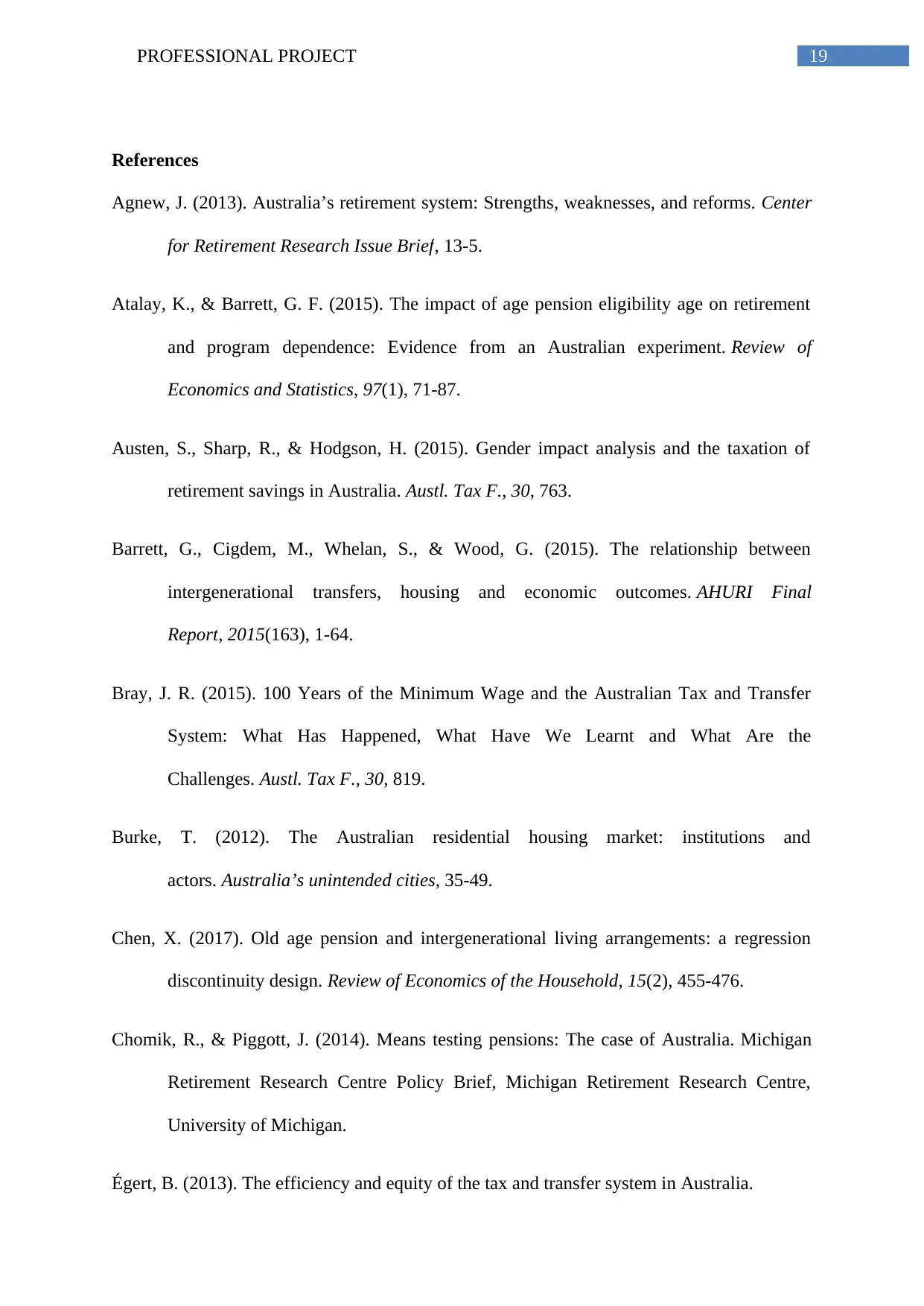
19PROFESSIONAL PROJECT
References
Agnew, J. (2013). Australia’s retirement system: Strengths, weaknesses, and reforms. Center
for Retirement Research Issue Brief, 13-5.
Atalay, K., & Barrett, G. F. (2015). The impact of age pension eligibility age on retirement
and program dependence: Evidence from an Australian experiment. Review of
Economics and Statistics, 97(1), 71-87.
Austen, S., Sharp, R., & Hodgson, H. (2015). Gender impact analysis and the taxation of
retirement savings in Australia. Austl. Tax F., 30, 763.
Barrett, G., Cigdem, M., Whelan, S., & Wood, G. (2015). The relationship between
intergenerational transfers, housing and economic outcomes. AHURI Final
Report, 2015(163), 1-64.
Bray, J. R. (2015). 100 Years of the Minimum Wage and the Australian Tax and Transfer
System: What Has Happened, What Have We Learnt and What Are the
Challenges. Austl. Tax F., 30, 819.
Burke, T. (2012). The Australian residential housing market: institutions and
actors. Australia’s unintended cities, 35-49.
Chen, X. (2017). Old age pension and intergenerational living arrangements: a regression
discontinuity design. Review of Economics of the Household, 15(2), 455-476.
Chomik, R., & Piggott, J. (2014). Means testing pensions: The case of Australia. Michigan
Retirement Research Centre Policy Brief, Michigan Retirement Research Centre,
University of Michigan.
Égert, B. (2013). The efficiency and equity of the tax and transfer system in Australia.
References
Agnew, J. (2013). Australia’s retirement system: Strengths, weaknesses, and reforms. Center
for Retirement Research Issue Brief, 13-5.
Atalay, K., & Barrett, G. F. (2015). The impact of age pension eligibility age on retirement
and program dependence: Evidence from an Australian experiment. Review of
Economics and Statistics, 97(1), 71-87.
Austen, S., Sharp, R., & Hodgson, H. (2015). Gender impact analysis and the taxation of
retirement savings in Australia. Austl. Tax F., 30, 763.
Barrett, G., Cigdem, M., Whelan, S., & Wood, G. (2015). The relationship between
intergenerational transfers, housing and economic outcomes. AHURI Final
Report, 2015(163), 1-64.
Bray, J. R. (2015). 100 Years of the Minimum Wage and the Australian Tax and Transfer
System: What Has Happened, What Have We Learnt and What Are the
Challenges. Austl. Tax F., 30, 819.
Burke, T. (2012). The Australian residential housing market: institutions and
actors. Australia’s unintended cities, 35-49.
Chen, X. (2017). Old age pension and intergenerational living arrangements: a regression
discontinuity design. Review of Economics of the Household, 15(2), 455-476.
Chomik, R., & Piggott, J. (2014). Means testing pensions: The case of Australia. Michigan
Retirement Research Centre Policy Brief, Michigan Retirement Research Centre,
University of Michigan.
Égert, B. (2013). The efficiency and equity of the tax and transfer system in Australia.
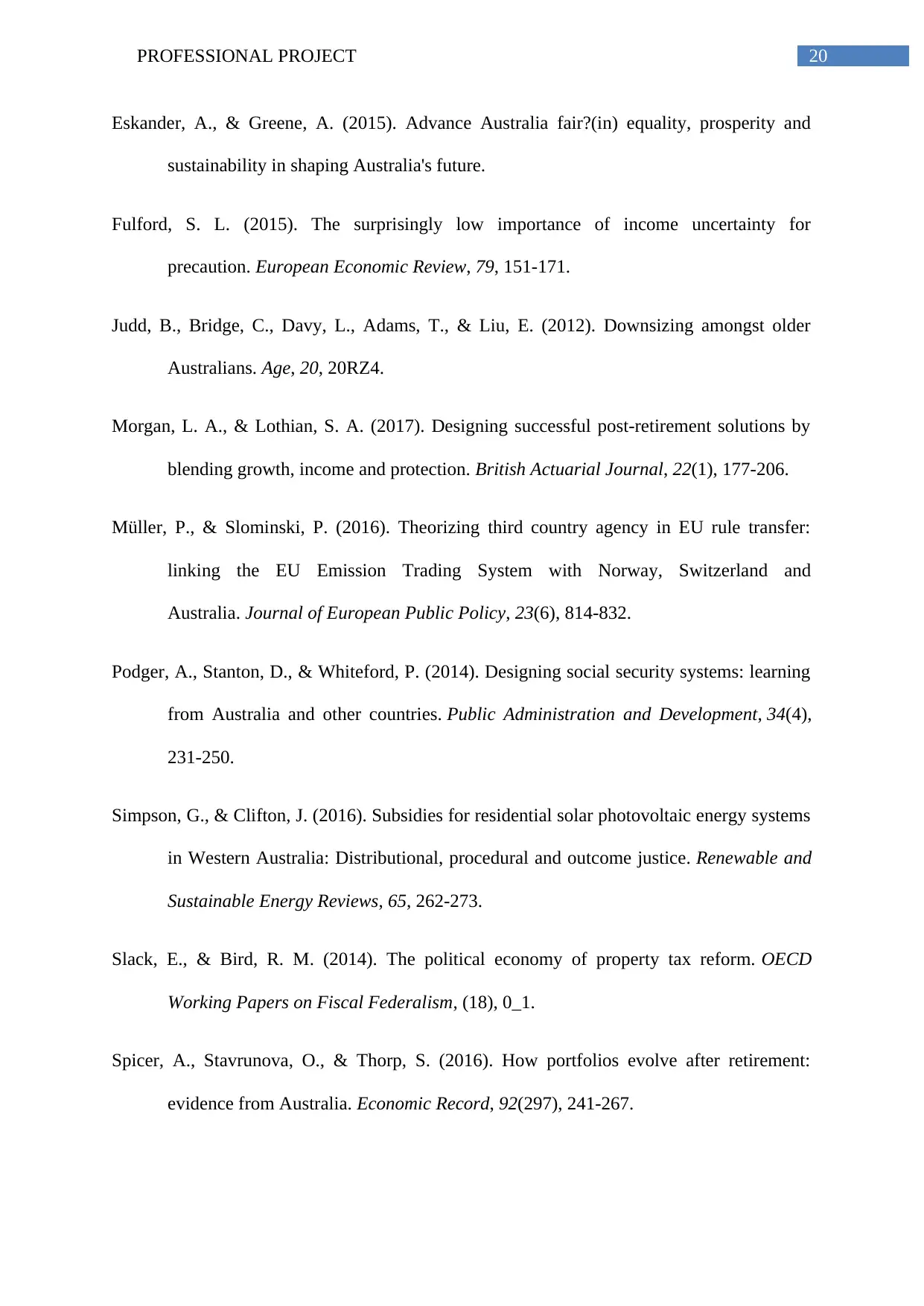
20PROFESSIONAL PROJECT
Eskander, A., & Greene, A. (2015). Advance Australia fair?(in) equality, prosperity and
sustainability in shaping Australia's future.
Fulford, S. L. (2015). The surprisingly low importance of income uncertainty for
precaution. European Economic Review, 79, 151-171.
Judd, B., Bridge, C., Davy, L., Adams, T., & Liu, E. (2012). Downsizing amongst older
Australians. Age, 20, 20RZ4.
Morgan, L. A., & Lothian, S. A. (2017). Designing successful post-retirement solutions by
blending growth, income and protection. British Actuarial Journal, 22(1), 177-206.
Müller, P., & Slominski, P. (2016). Theorizing third country agency in EU rule transfer:
linking the EU Emission Trading System with Norway, Switzerland and
Australia. Journal of European Public Policy, 23(6), 814-832.
Podger, A., Stanton, D., & Whiteford, P. (2014). Designing social security systems: learning
from Australia and other countries. Public Administration and Development, 34(4),
231-250.
Simpson, G., & Clifton, J. (2016). Subsidies for residential solar photovoltaic energy systems
in Western Australia: Distributional, procedural and outcome justice. Renewable and
Sustainable Energy Reviews, 65, 262-273.
Slack, E., & Bird, R. M. (2014). The political economy of property tax reform. OECD
Working Papers on Fiscal Federalism, (18), 0_1.
Spicer, A., Stavrunova, O., & Thorp, S. (2016). How portfolios evolve after retirement:
evidence from Australia. Economic Record, 92(297), 241-267.
Eskander, A., & Greene, A. (2015). Advance Australia fair?(in) equality, prosperity and
sustainability in shaping Australia's future.
Fulford, S. L. (2015). The surprisingly low importance of income uncertainty for
precaution. European Economic Review, 79, 151-171.
Judd, B., Bridge, C., Davy, L., Adams, T., & Liu, E. (2012). Downsizing amongst older
Australians. Age, 20, 20RZ4.
Morgan, L. A., & Lothian, S. A. (2017). Designing successful post-retirement solutions by
blending growth, income and protection. British Actuarial Journal, 22(1), 177-206.
Müller, P., & Slominski, P. (2016). Theorizing third country agency in EU rule transfer:
linking the EU Emission Trading System with Norway, Switzerland and
Australia. Journal of European Public Policy, 23(6), 814-832.
Podger, A., Stanton, D., & Whiteford, P. (2014). Designing social security systems: learning
from Australia and other countries. Public Administration and Development, 34(4),
231-250.
Simpson, G., & Clifton, J. (2016). Subsidies for residential solar photovoltaic energy systems
in Western Australia: Distributional, procedural and outcome justice. Renewable and
Sustainable Energy Reviews, 65, 262-273.
Slack, E., & Bird, R. M. (2014). The political economy of property tax reform. OECD
Working Papers on Fiscal Federalism, (18), 0_1.
Spicer, A., Stavrunova, O., & Thorp, S. (2016). How portfolios evolve after retirement:
evidence from Australia. Economic Record, 92(297), 241-267.
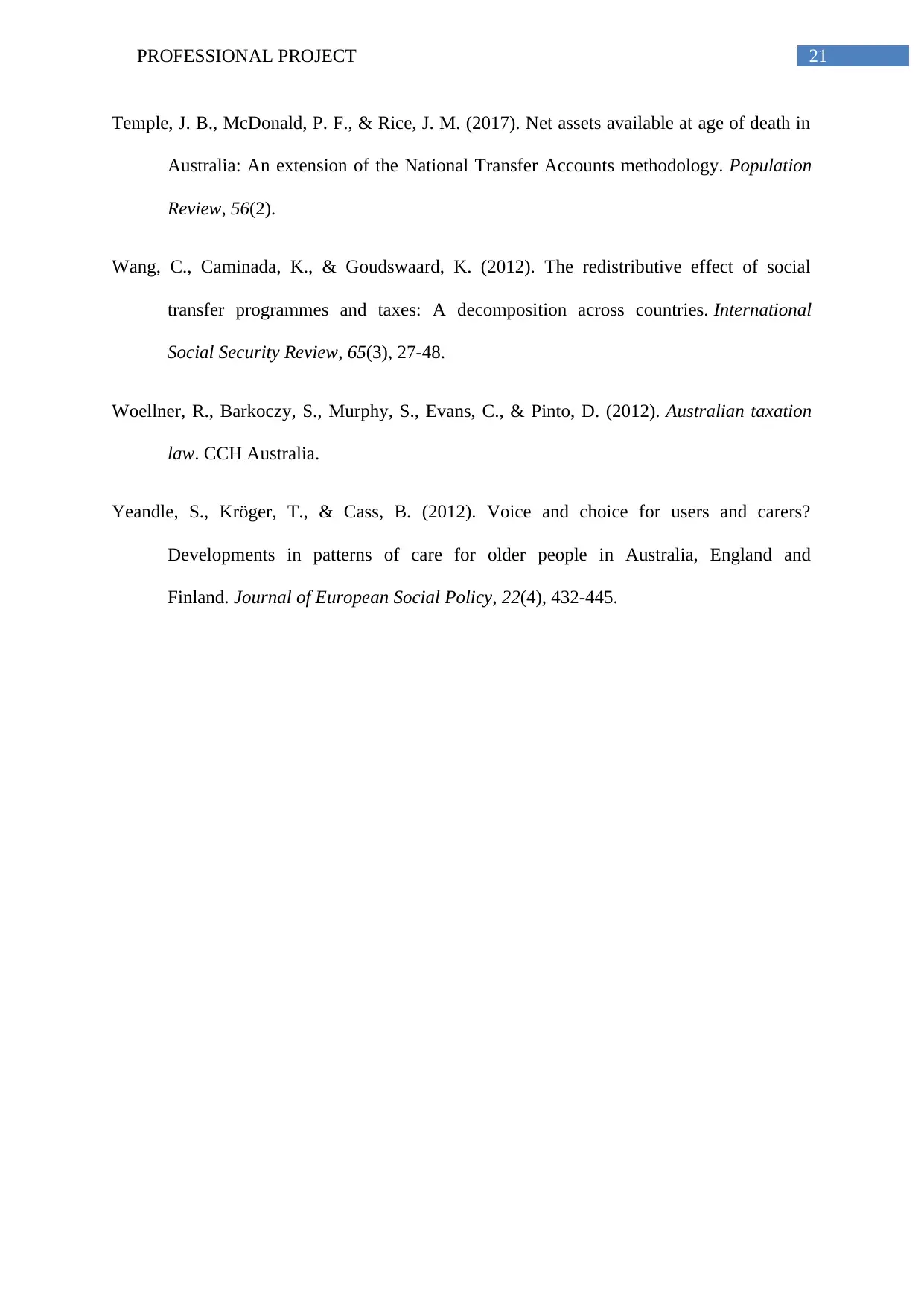
21PROFESSIONAL PROJECT
Temple, J. B., McDonald, P. F., & Rice, J. M. (2017). Net assets available at age of death in
Australia: An extension of the National Transfer Accounts methodology. Population
Review, 56(2).
Wang, C., Caminada, K., & Goudswaard, K. (2012). The redistributive effect of social
transfer programmes and taxes: A decomposition across countries. International
Social Security Review, 65(3), 27-48.
Woellner, R., Barkoczy, S., Murphy, S., Evans, C., & Pinto, D. (2012). Australian taxation
law. CCH Australia.
Yeandle, S., Kröger, T., & Cass, B. (2012). Voice and choice for users and carers?
Developments in patterns of care for older people in Australia, England and
Finland. Journal of European Social Policy, 22(4), 432-445.
Temple, J. B., McDonald, P. F., & Rice, J. M. (2017). Net assets available at age of death in
Australia: An extension of the National Transfer Accounts methodology. Population
Review, 56(2).
Wang, C., Caminada, K., & Goudswaard, K. (2012). The redistributive effect of social
transfer programmes and taxes: A decomposition across countries. International
Social Security Review, 65(3), 27-48.
Woellner, R., Barkoczy, S., Murphy, S., Evans, C., & Pinto, D. (2012). Australian taxation
law. CCH Australia.
Yeandle, S., Kröger, T., & Cass, B. (2012). Voice and choice for users and carers?
Developments in patterns of care for older people in Australia, England and
Finland. Journal of European Social Policy, 22(4), 432-445.
Secure Best Marks with AI Grader
Need help grading? Try our AI Grader for instant feedback on your assignments.
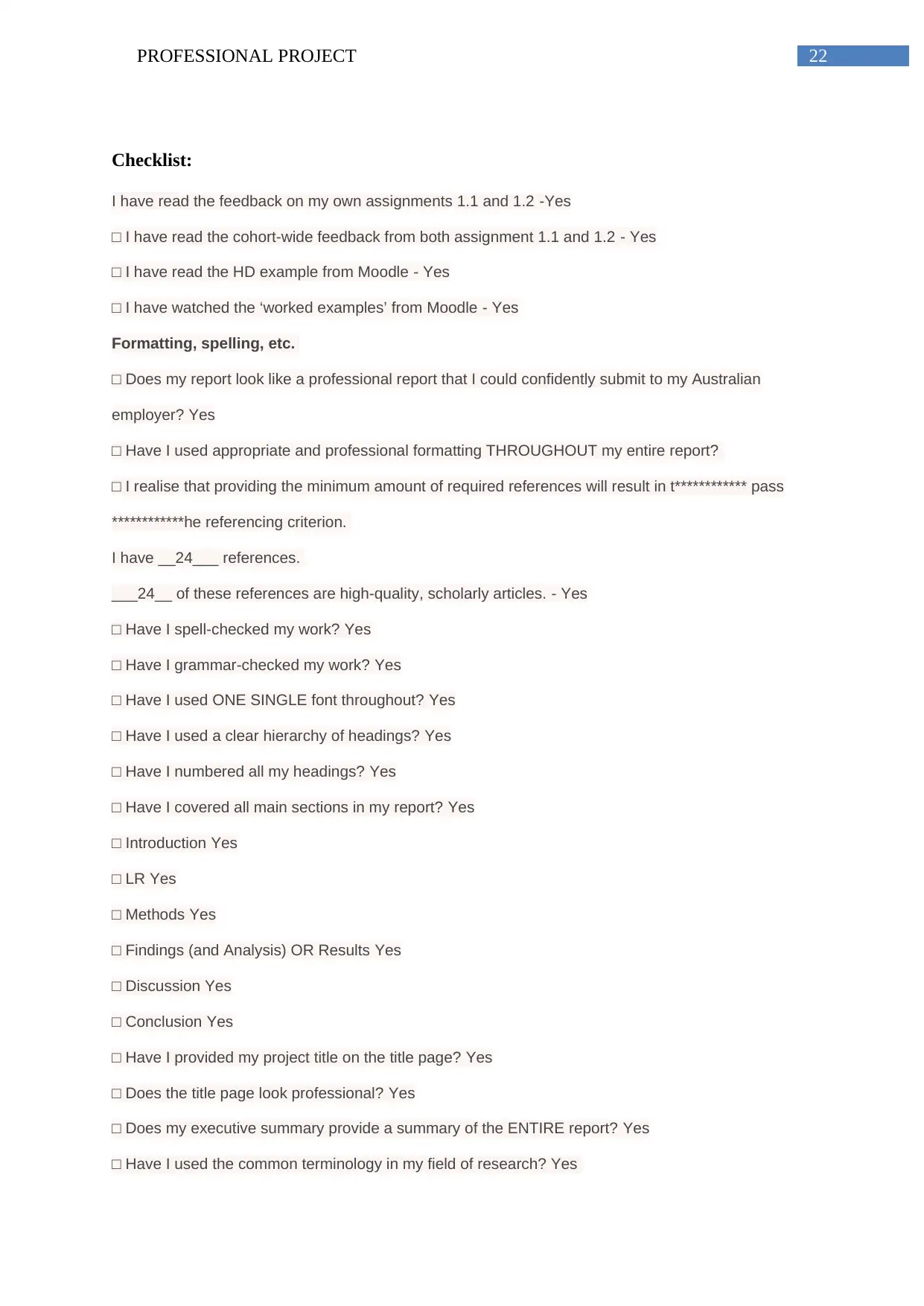
22PROFESSIONAL PROJECT
Checklist:
I have read the feedback on my own assignments 1.1 and 1.2 -Yes
□ I have read the cohort-wide feedback from both assignment 1.1 and 1.2 - Yes
□ I have read the HD example from Moodle - Yes
□ I have watched the ‘worked examples’ from Moodle - Yes
Formatting, spelling, etc.
□ Does my report look like a professional report that I could confidently submit to my Australian
employer? Yes
□ Have I used appropriate and professional formatting THROUGHOUT my entire report?
□ I realise that providing the minimum amount of required references will result in t************ pass
************he referencing criterion.
I have __24___ references.
___24__ of these references are high-quality, scholarly articles. - Yes
□ Have I spell-checked my work? Yes
□ Have I grammar-checked my work? Yes
□ Have I used ONE SINGLE font throughout? Yes
□ Have I used a clear hierarchy of headings? Yes
□ Have I numbered all my headings? Yes
□ Have I covered all main sections in my report? Yes
□ Introduction Yes
□ LR Yes
□ Methods Yes
□ Findings (and Analysis) OR Results Yes
□ Discussion Yes
□ Conclusion Yes
□ Have I provided my project title on the title page? Yes
□ Does the title page look professional? Yes
□ Does my executive summary provide a summary of the ENTIRE report? Yes
□ Have I used the common terminology in my field of research? Yes
Checklist:
I have read the feedback on my own assignments 1.1 and 1.2 -Yes
□ I have read the cohort-wide feedback from both assignment 1.1 and 1.2 - Yes
□ I have read the HD example from Moodle - Yes
□ I have watched the ‘worked examples’ from Moodle - Yes
Formatting, spelling, etc.
□ Does my report look like a professional report that I could confidently submit to my Australian
employer? Yes
□ Have I used appropriate and professional formatting THROUGHOUT my entire report?
□ I realise that providing the minimum amount of required references will result in t************ pass
************he referencing criterion.
I have __24___ references.
___24__ of these references are high-quality, scholarly articles. - Yes
□ Have I spell-checked my work? Yes
□ Have I grammar-checked my work? Yes
□ Have I used ONE SINGLE font throughout? Yes
□ Have I used a clear hierarchy of headings? Yes
□ Have I numbered all my headings? Yes
□ Have I covered all main sections in my report? Yes
□ Introduction Yes
□ LR Yes
□ Methods Yes
□ Findings (and Analysis) OR Results Yes
□ Discussion Yes
□ Conclusion Yes
□ Have I provided my project title on the title page? Yes
□ Does the title page look professional? Yes
□ Does my executive summary provide a summary of the ENTIRE report? Yes
□ Have I used the common terminology in my field of research? Yes

23PROFESSIONAL PROJECT
□ Have I included page numbers? Yes
□ Have I included a table of contents? Yes
□ I have considered other ways of making my report look professional, e.g. table of figures, list of
abbreviations, or glossary of terms Yes
□ I have checked that all other elements (e.g. glossary) are neat and professional-looking
Introduction and LR Yes
□ Have I covered the below items in my introduction or LR? Yes
□ Justification of the topic Yes
□ Clear aim and RQs Yes
□ Have I referenced every claim I have made? Yes
□ Was I critical in my LR? Yes
□ Have I put every reference from my LR into my reference list? Yes
□ Have I included page numbers and “ “ for direct quotes? Yes
□ Have I referenced in-text sources in APA style? Yes
□ Have I defined key terms, either in the introduction, or the LR or in a glossary of terms? Yes
Methods
□ Does my methods section clarify my broad approach? Yes
□ Does my methods section justify my broad approach? Yes
□ Does my methods section clarify the specific activities I undertook? Yes
□ Does my methods section justify the specific activities I undertook? Yes
□ I have included only those approaches that I actually used. Yes
□ Have I used appropriate research methods terminology in my methods section? Yes
□ Have I got suitable references in my methods section? Yes
□ Are they in APA style? □ Are they in the reference list? Yes
□ Could my methods be replicated by someone else? Yes
□ I have included sampling approach(es) Yes
□ I have explained my population Yes
□ I have explained where my data comes from (data collection) Yes
□ I have explained my variables and how I measured them (if QUANT) Yes
□ Have I included page numbers? Yes
□ Have I included a table of contents? Yes
□ I have considered other ways of making my report look professional, e.g. table of figures, list of
abbreviations, or glossary of terms Yes
□ I have checked that all other elements (e.g. glossary) are neat and professional-looking
Introduction and LR Yes
□ Have I covered the below items in my introduction or LR? Yes
□ Justification of the topic Yes
□ Clear aim and RQs Yes
□ Have I referenced every claim I have made? Yes
□ Was I critical in my LR? Yes
□ Have I put every reference from my LR into my reference list? Yes
□ Have I included page numbers and “ “ for direct quotes? Yes
□ Have I referenced in-text sources in APA style? Yes
□ Have I defined key terms, either in the introduction, or the LR or in a glossary of terms? Yes
Methods
□ Does my methods section clarify my broad approach? Yes
□ Does my methods section justify my broad approach? Yes
□ Does my methods section clarify the specific activities I undertook? Yes
□ Does my methods section justify the specific activities I undertook? Yes
□ I have included only those approaches that I actually used. Yes
□ Have I used appropriate research methods terminology in my methods section? Yes
□ Have I got suitable references in my methods section? Yes
□ Are they in APA style? □ Are they in the reference list? Yes
□ Could my methods be replicated by someone else? Yes
□ I have included sampling approach(es) Yes
□ I have explained my population Yes
□ I have explained where my data comes from (data collection) Yes
□ I have explained my variables and how I measured them (if QUANT) Yes
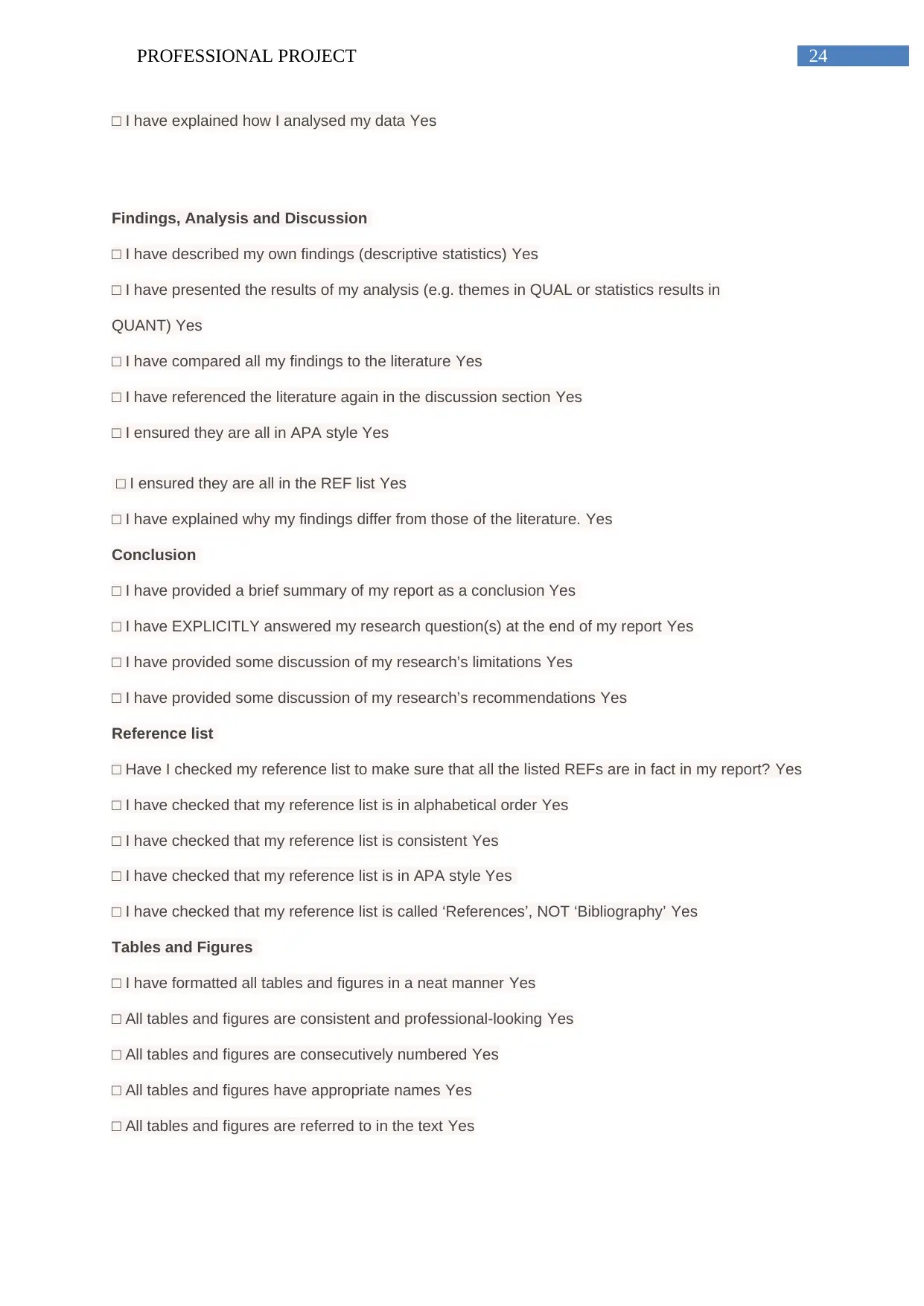
24PROFESSIONAL PROJECT
□ I have explained how I analysed my data Yes
Findings, Analysis and Discussion
□ I have described my own findings (descriptive statistics) Yes
□ I have presented the results of my analysis (e.g. themes in QUAL or statistics results in
QUANT) Yes
□ I have compared all my findings to the literature Yes
□ I have referenced the literature again in the discussion section Yes
□ I ensured they are all in APA style Yes
□ I ensured they are all in the REF list Yes
□ I have explained why my findings differ from those of the literature. Yes
Conclusion
□ I have provided a brief summary of my report as a conclusion Yes
□ I have EXPLICITLY answered my research question(s) at the end of my report Yes
□ I have provided some discussion of my research’s limitations Yes
□ I have provided some discussion of my research’s recommendations Yes
Reference list
□ Have I checked my reference list to make sure that all the listed REFs are in fact in my report? Yes
□ I have checked that my reference list is in alphabetical order Yes
□ I have checked that my reference list is consistent Yes
□ I have checked that my reference list is in APA style Yes
□ I have checked that my reference list is called ‘References’, NOT ‘Bibliography’ Yes
Tables and Figures
□ I have formatted all tables and figures in a neat manner Yes
□ All tables and figures are consistent and professional-looking Yes
□ All tables and figures are consecutively numbered Yes
□ All tables and figures have appropriate names Yes
□ All tables and figures are referred to in the text Yes
□ I have explained how I analysed my data Yes
Findings, Analysis and Discussion
□ I have described my own findings (descriptive statistics) Yes
□ I have presented the results of my analysis (e.g. themes in QUAL or statistics results in
QUANT) Yes
□ I have compared all my findings to the literature Yes
□ I have referenced the literature again in the discussion section Yes
□ I ensured they are all in APA style Yes
□ I ensured they are all in the REF list Yes
□ I have explained why my findings differ from those of the literature. Yes
Conclusion
□ I have provided a brief summary of my report as a conclusion Yes
□ I have EXPLICITLY answered my research question(s) at the end of my report Yes
□ I have provided some discussion of my research’s limitations Yes
□ I have provided some discussion of my research’s recommendations Yes
Reference list
□ Have I checked my reference list to make sure that all the listed REFs are in fact in my report? Yes
□ I have checked that my reference list is in alphabetical order Yes
□ I have checked that my reference list is consistent Yes
□ I have checked that my reference list is in APA style Yes
□ I have checked that my reference list is called ‘References’, NOT ‘Bibliography’ Yes
Tables and Figures
□ I have formatted all tables and figures in a neat manner Yes
□ All tables and figures are consistent and professional-looking Yes
□ All tables and figures are consecutively numbered Yes
□ All tables and figures have appropriate names Yes
□ All tables and figures are referred to in the text Yes
Paraphrase This Document
Need a fresh take? Get an instant paraphrase of this document with our AI Paraphraser

25PROFESSIONAL PROJECT
1 out of 26
Related Documents
Your All-in-One AI-Powered Toolkit for Academic Success.
+13062052269
info@desklib.com
Available 24*7 on WhatsApp / Email
![[object Object]](/_next/static/media/star-bottom.7253800d.svg)
Unlock your academic potential
© 2024 | Zucol Services PVT LTD | All rights reserved.





